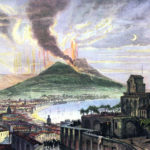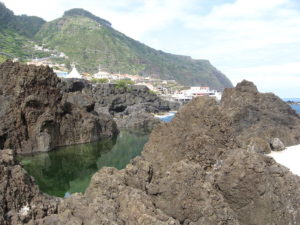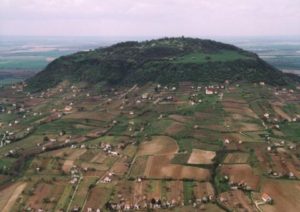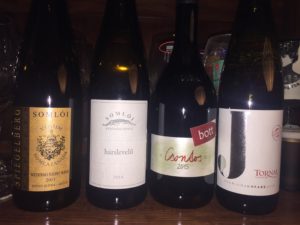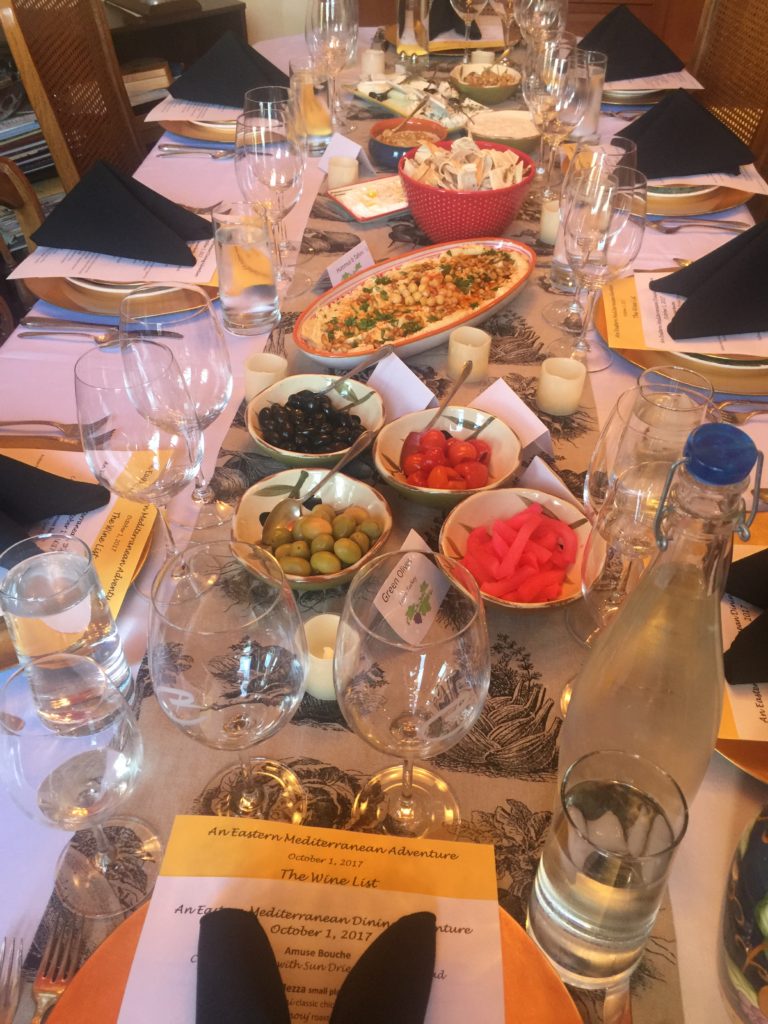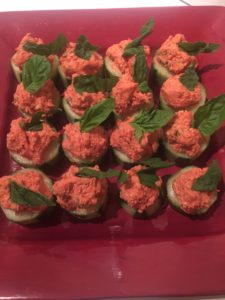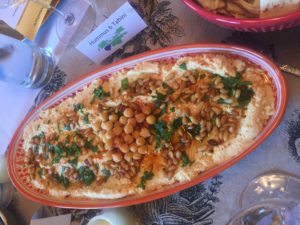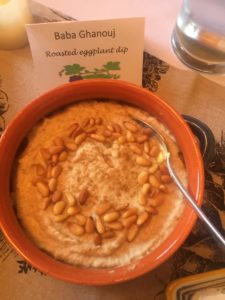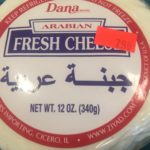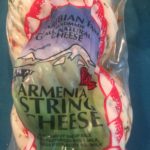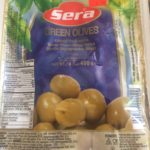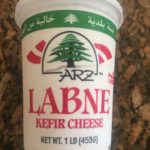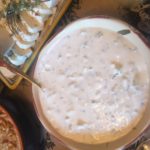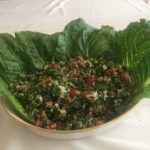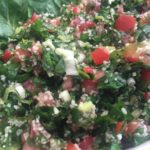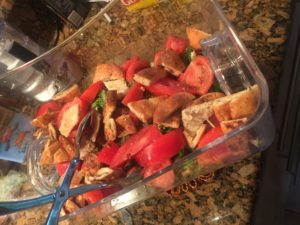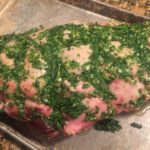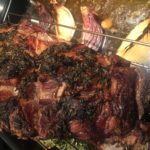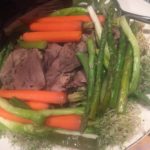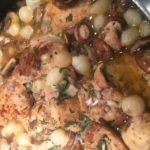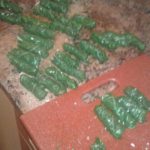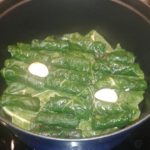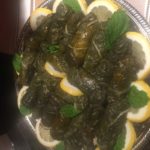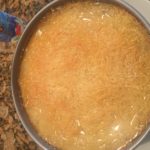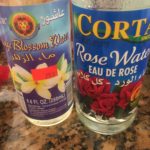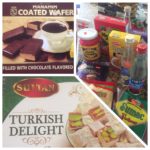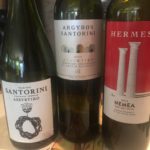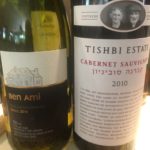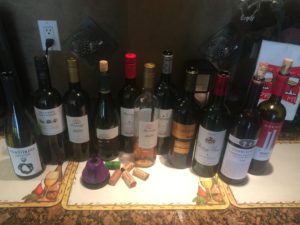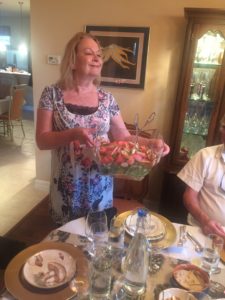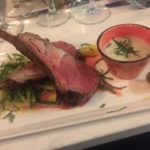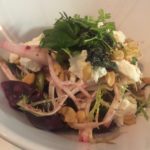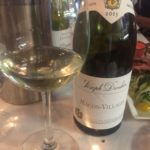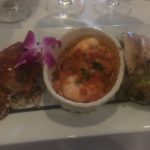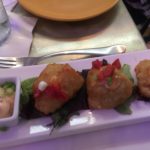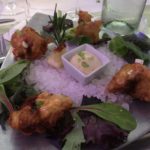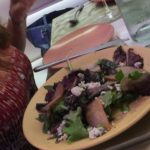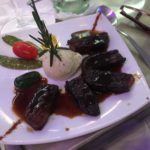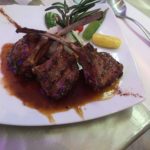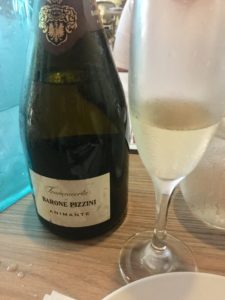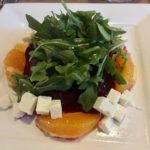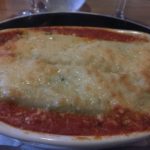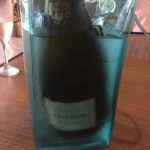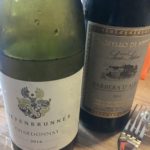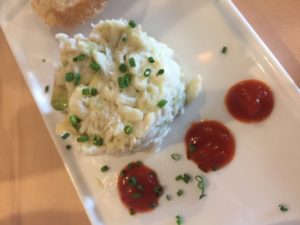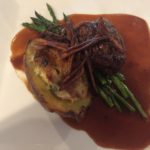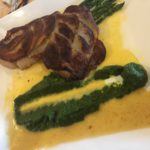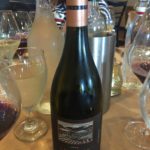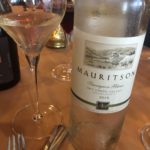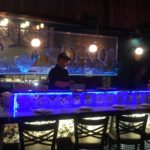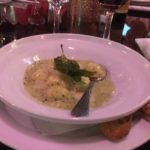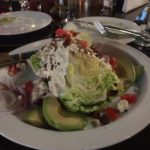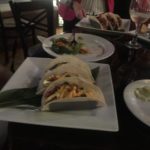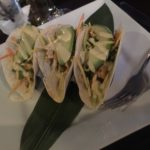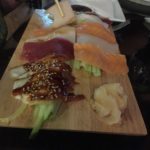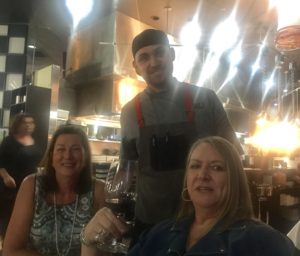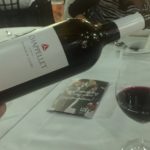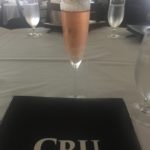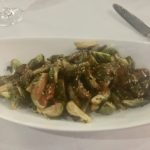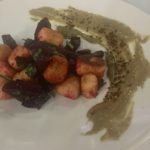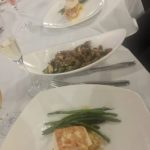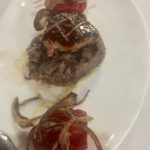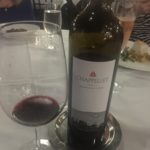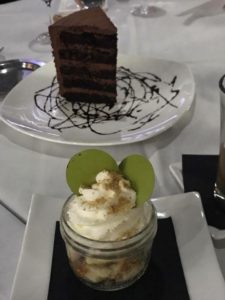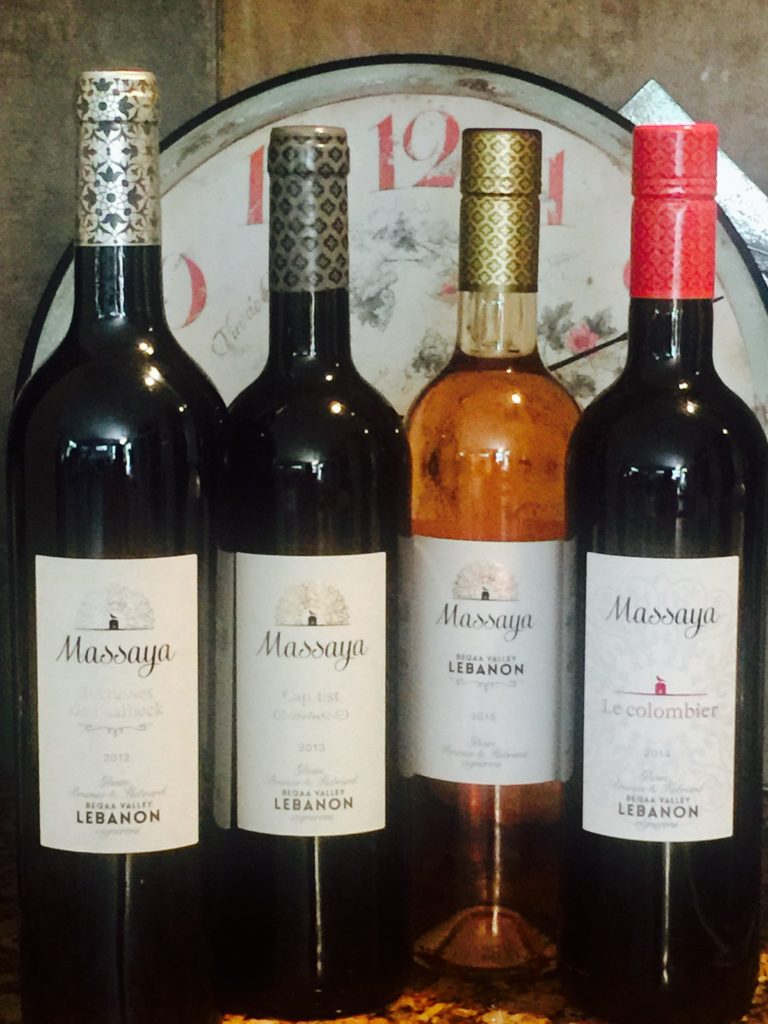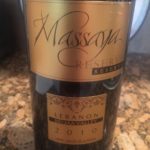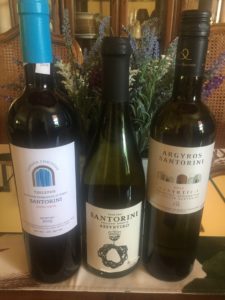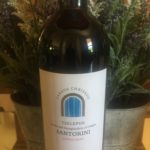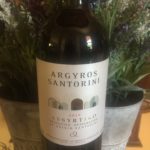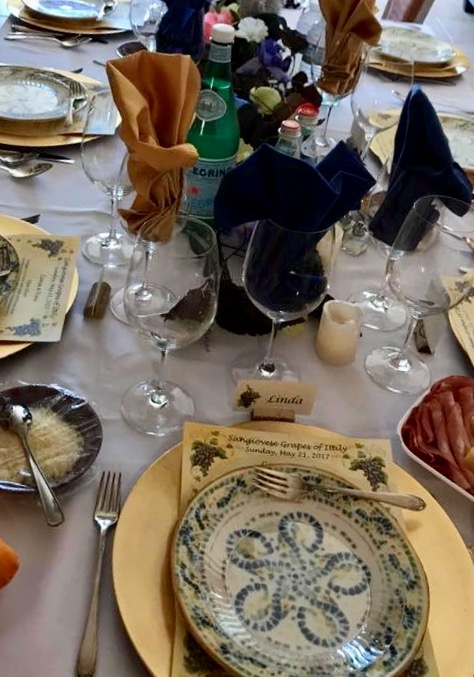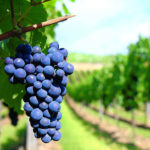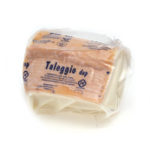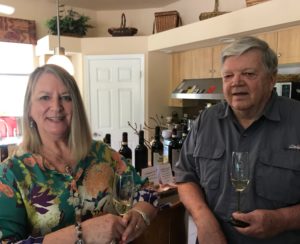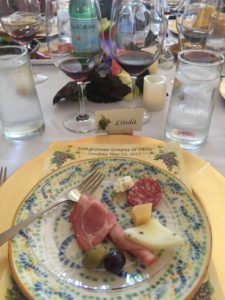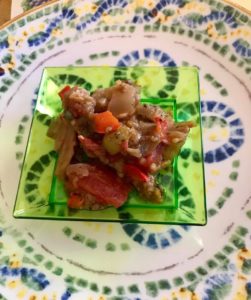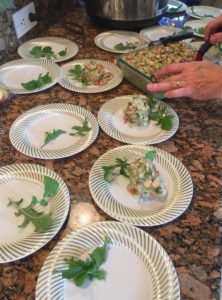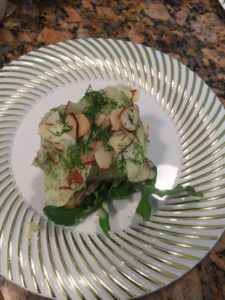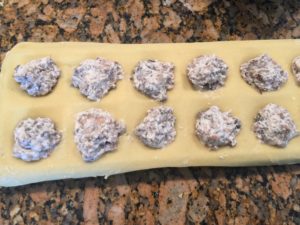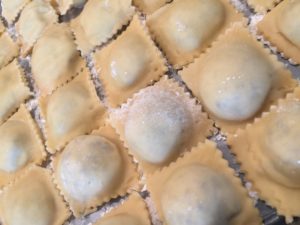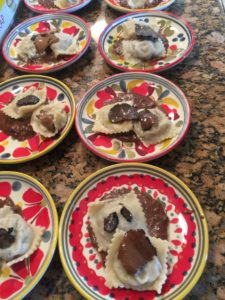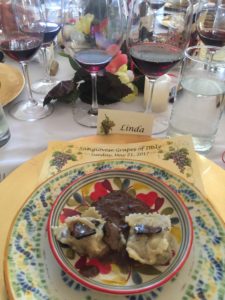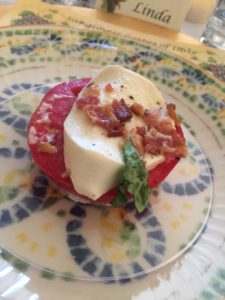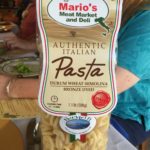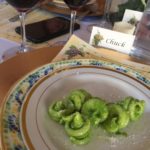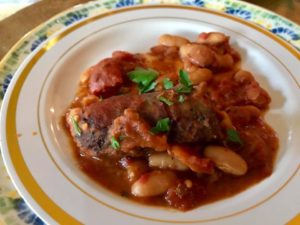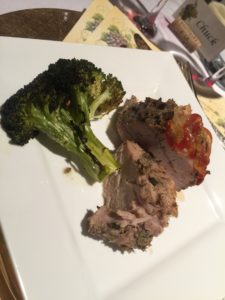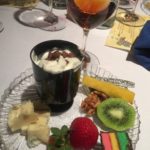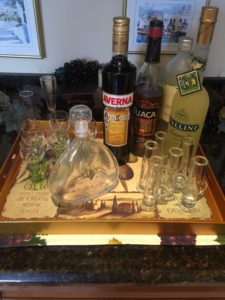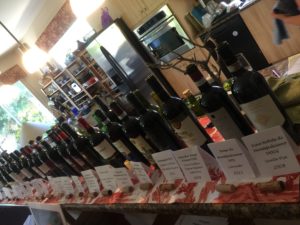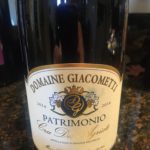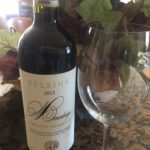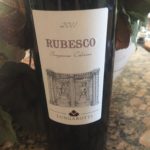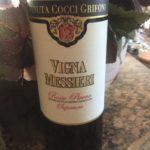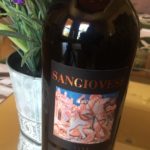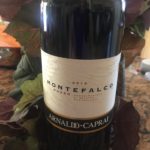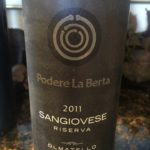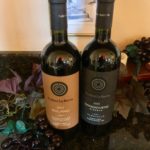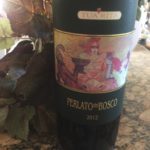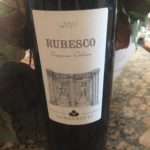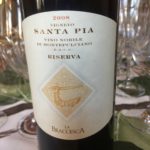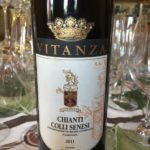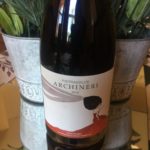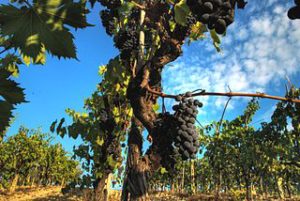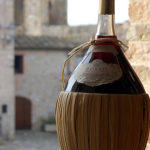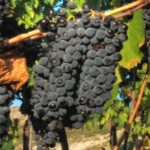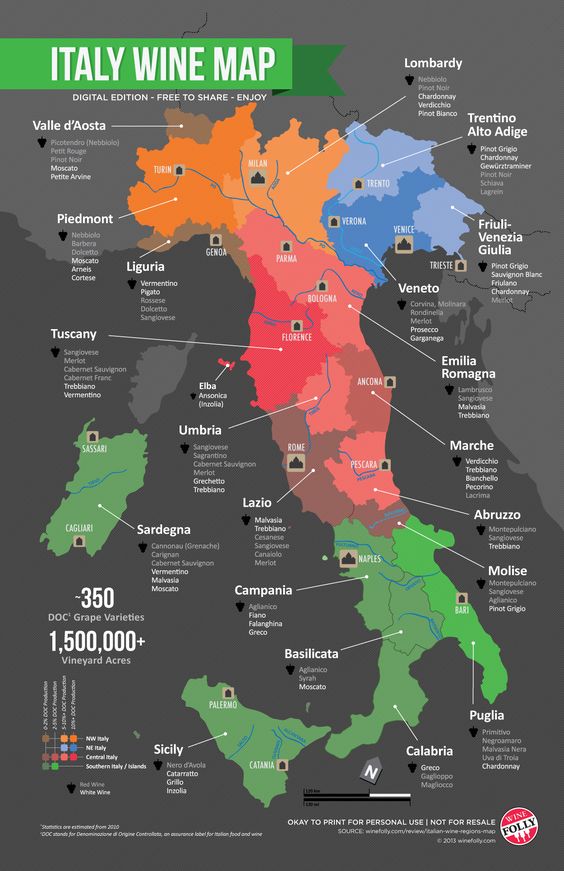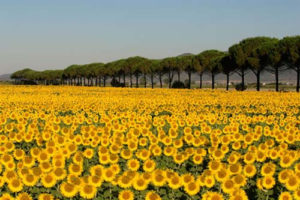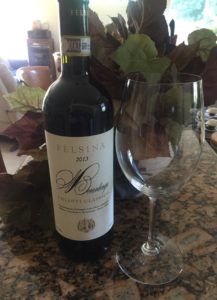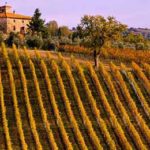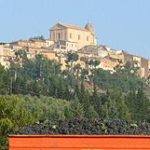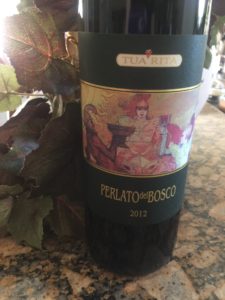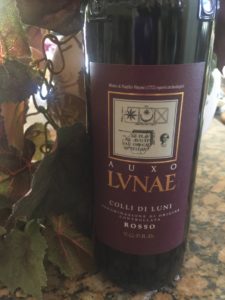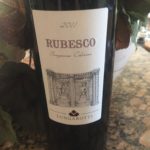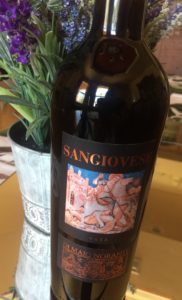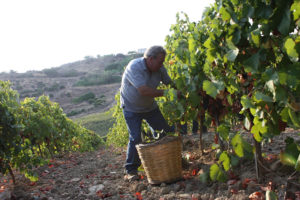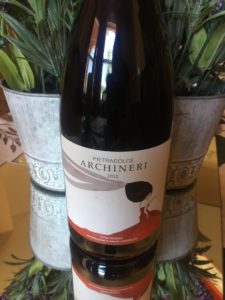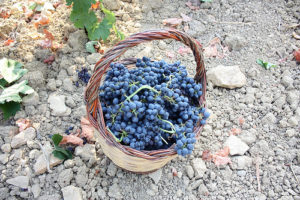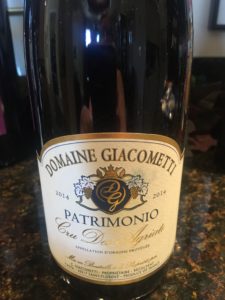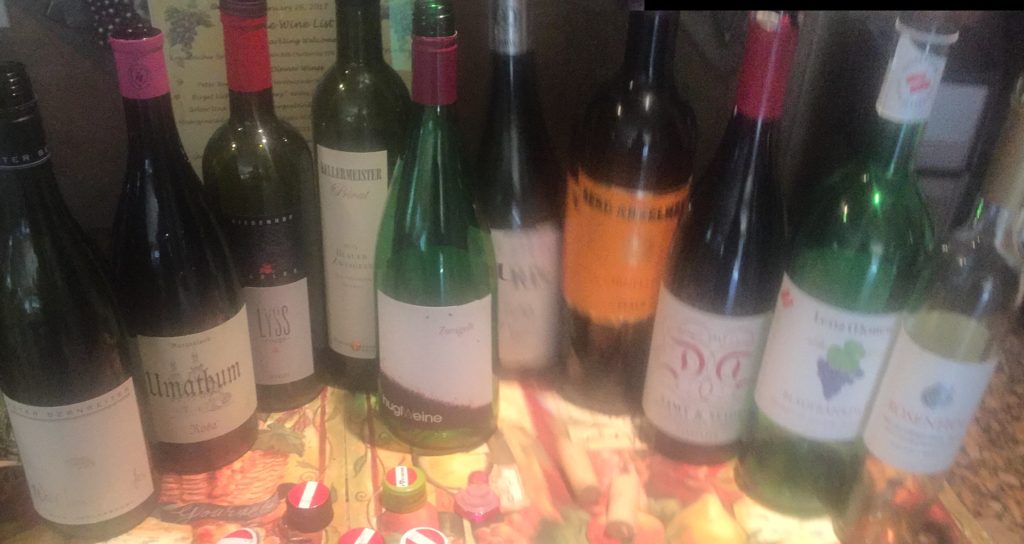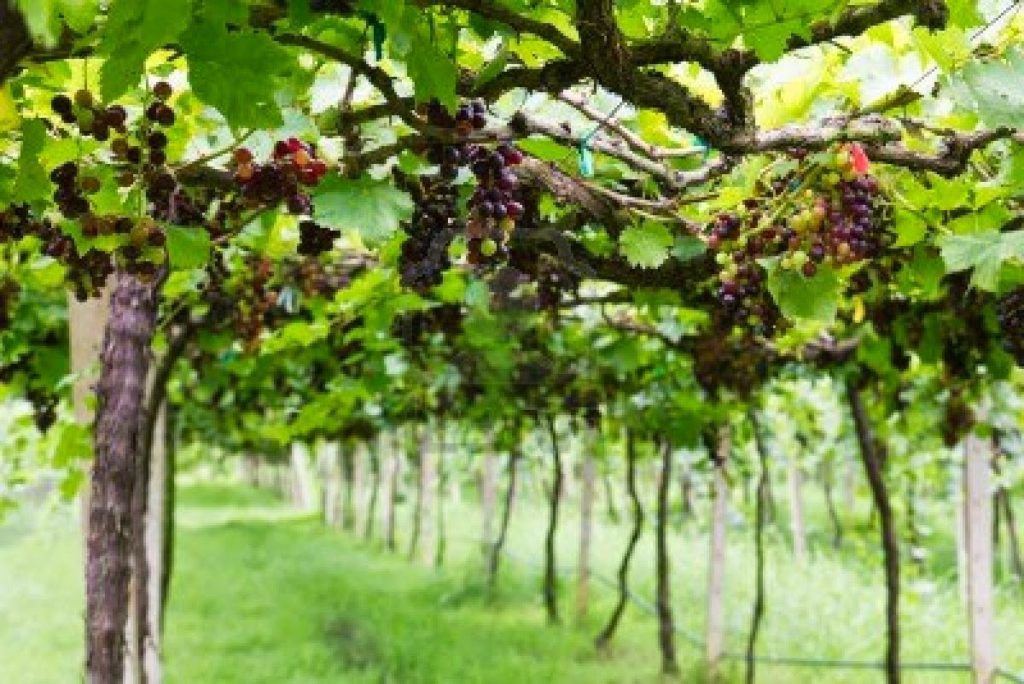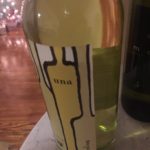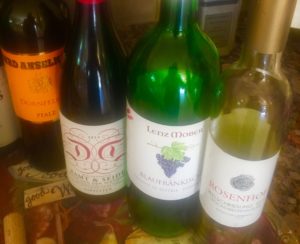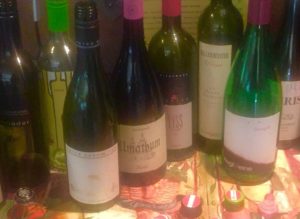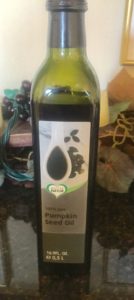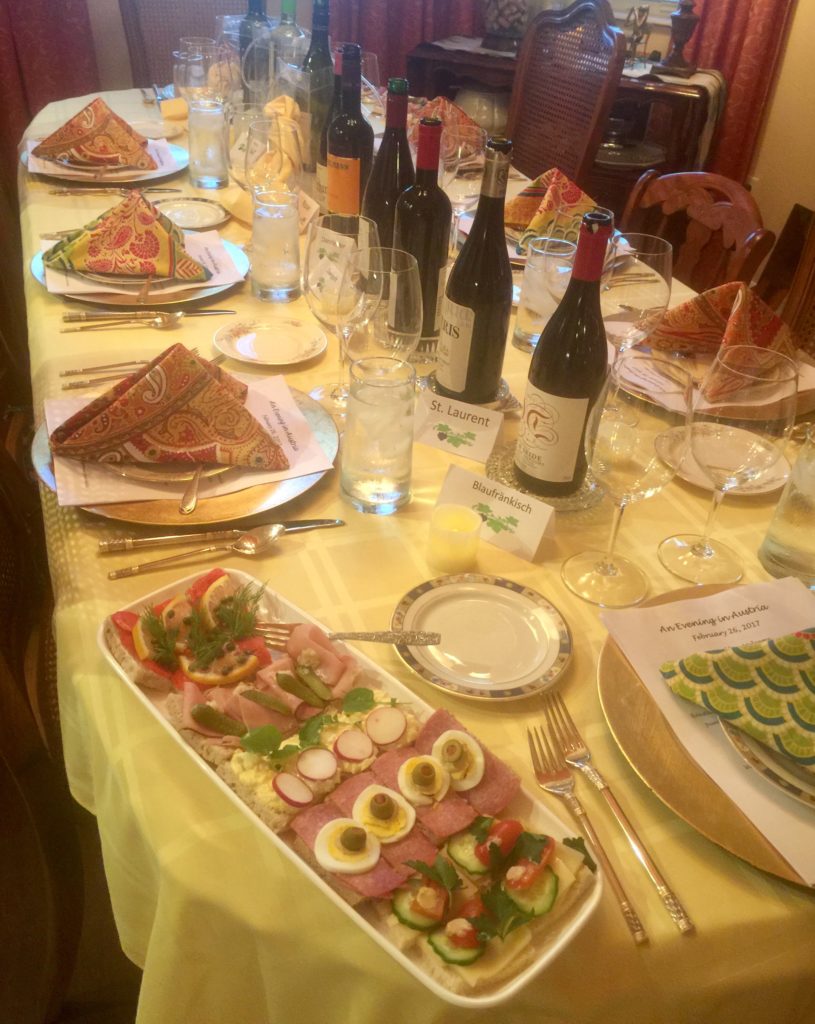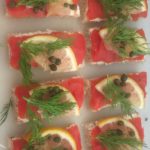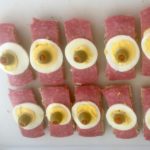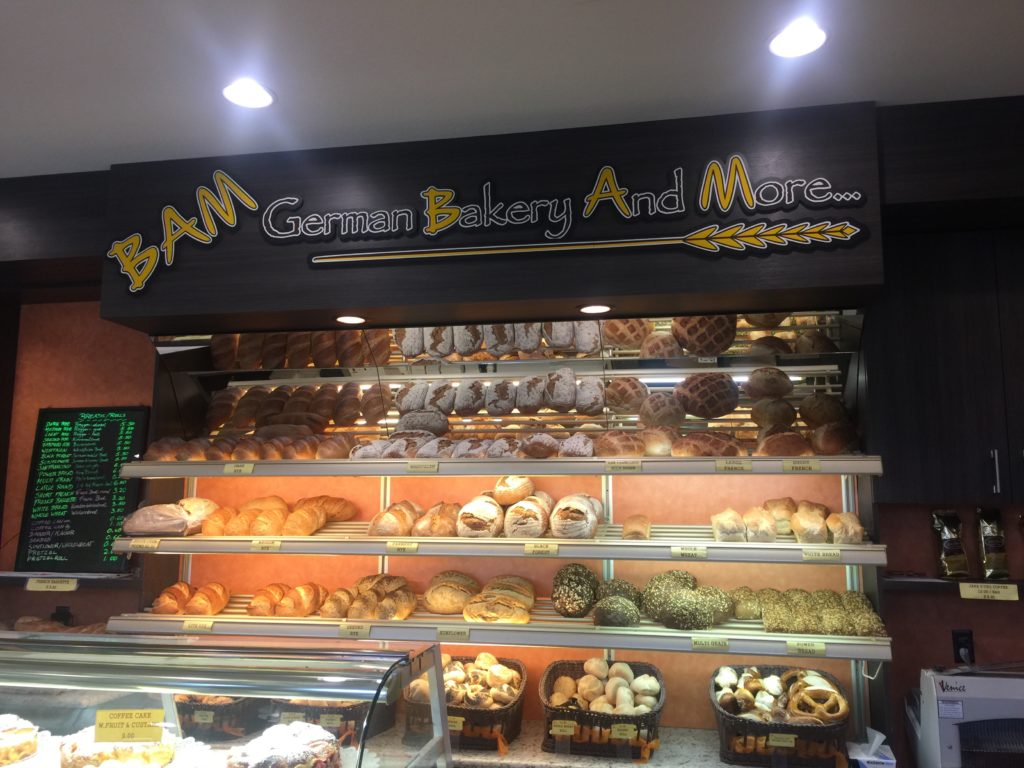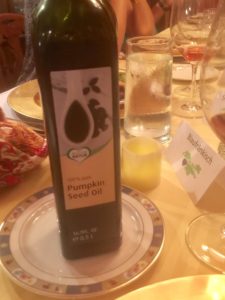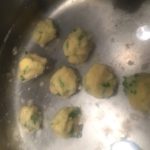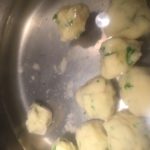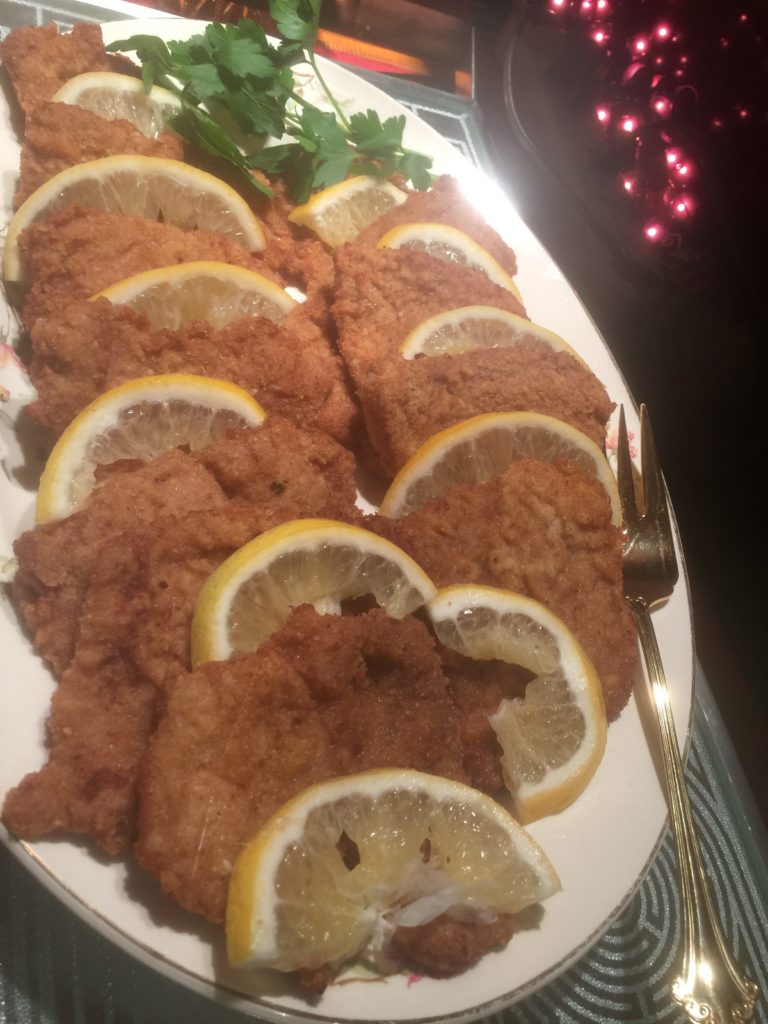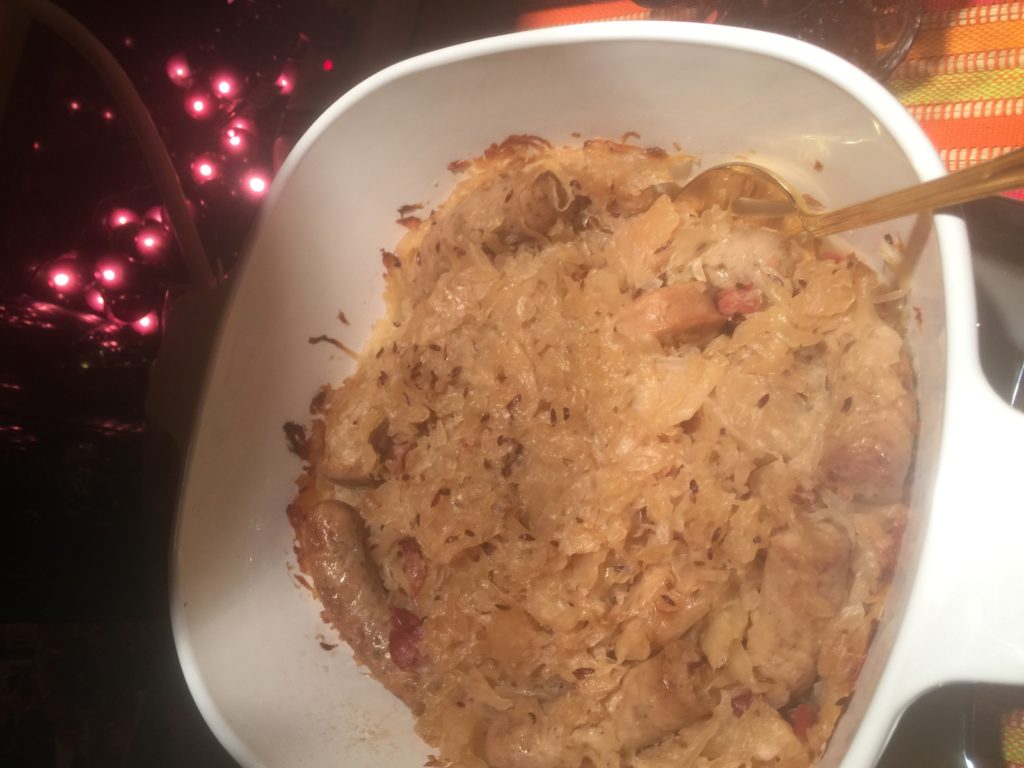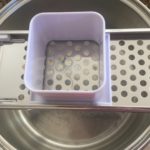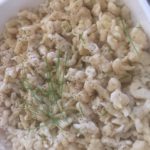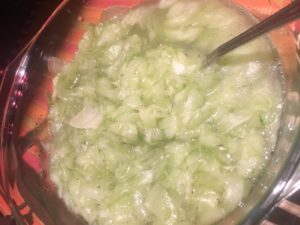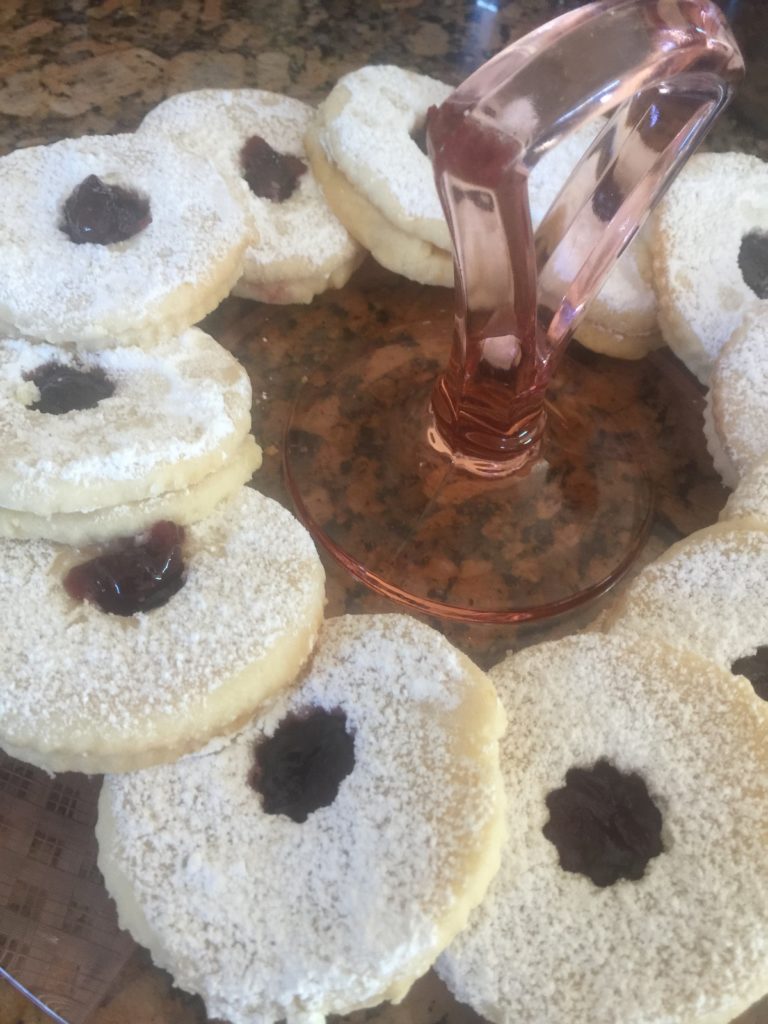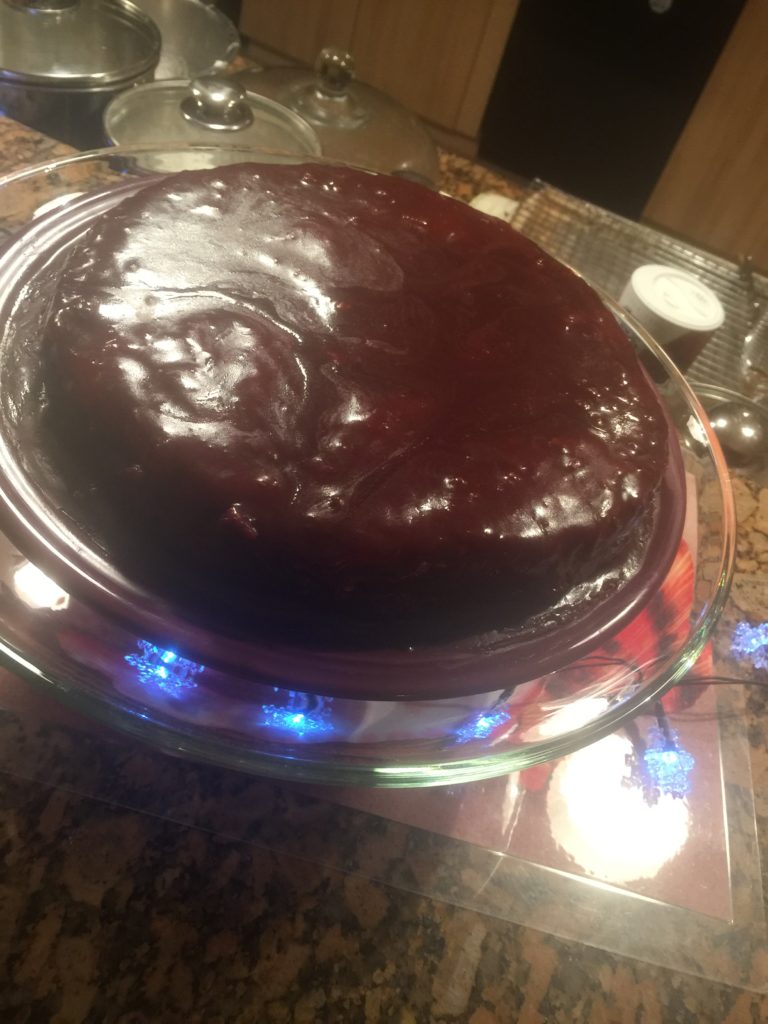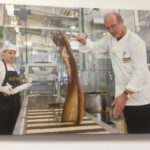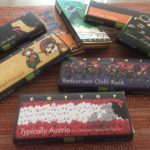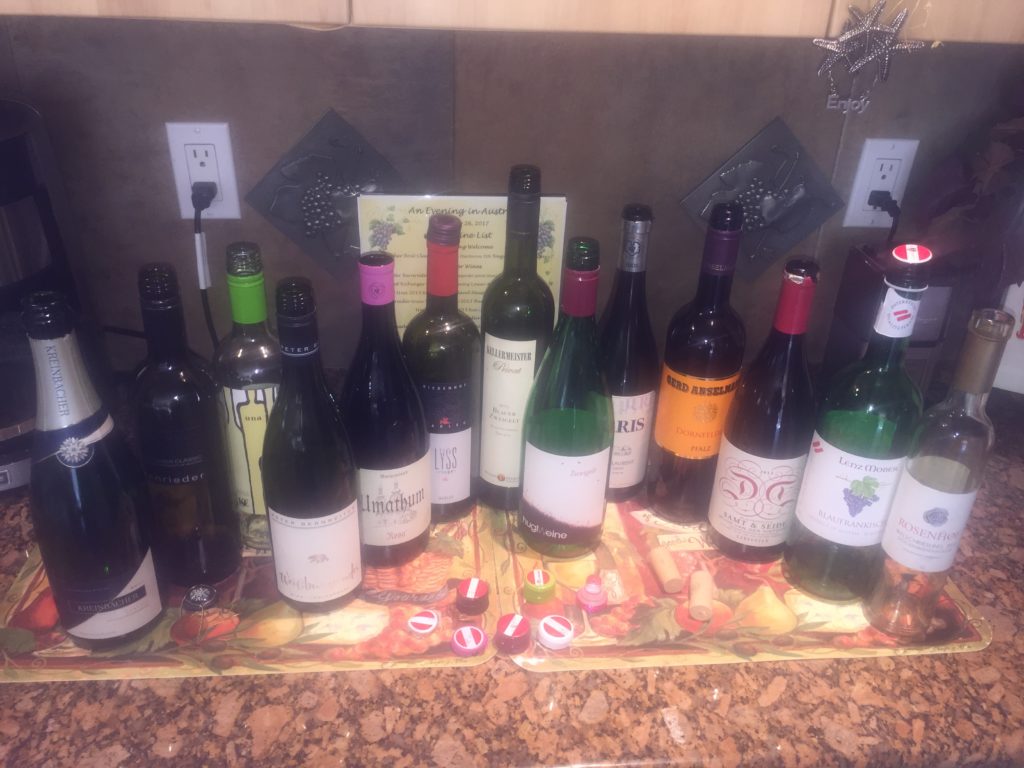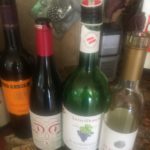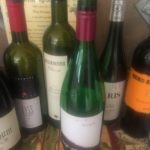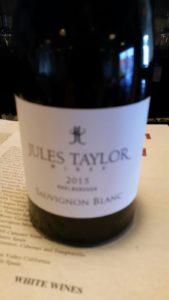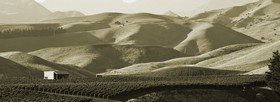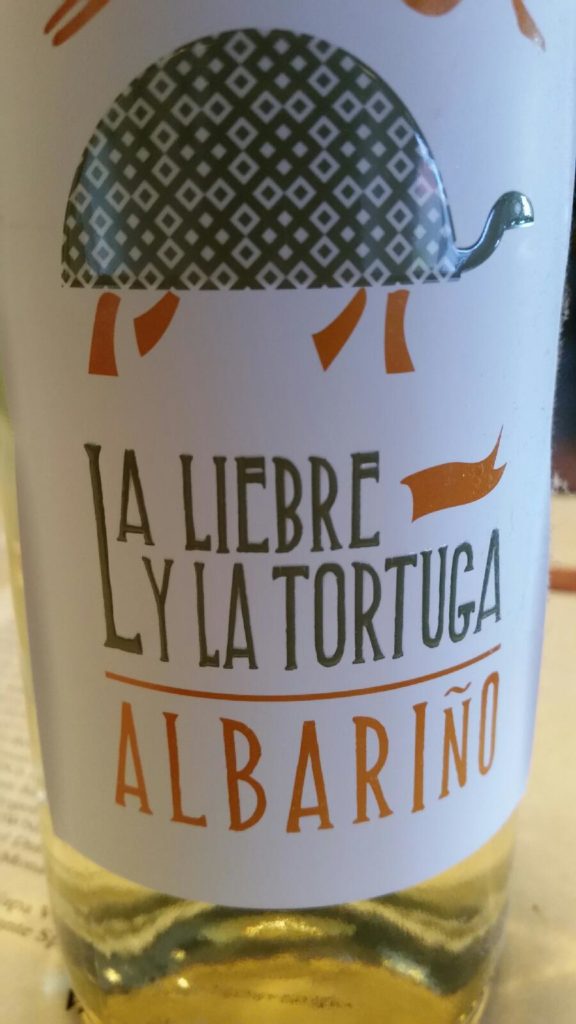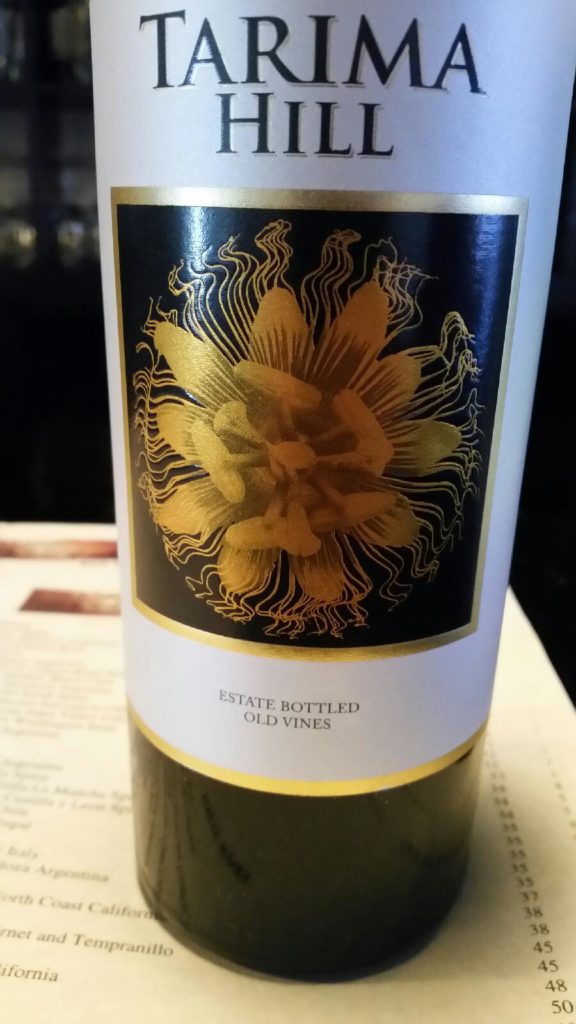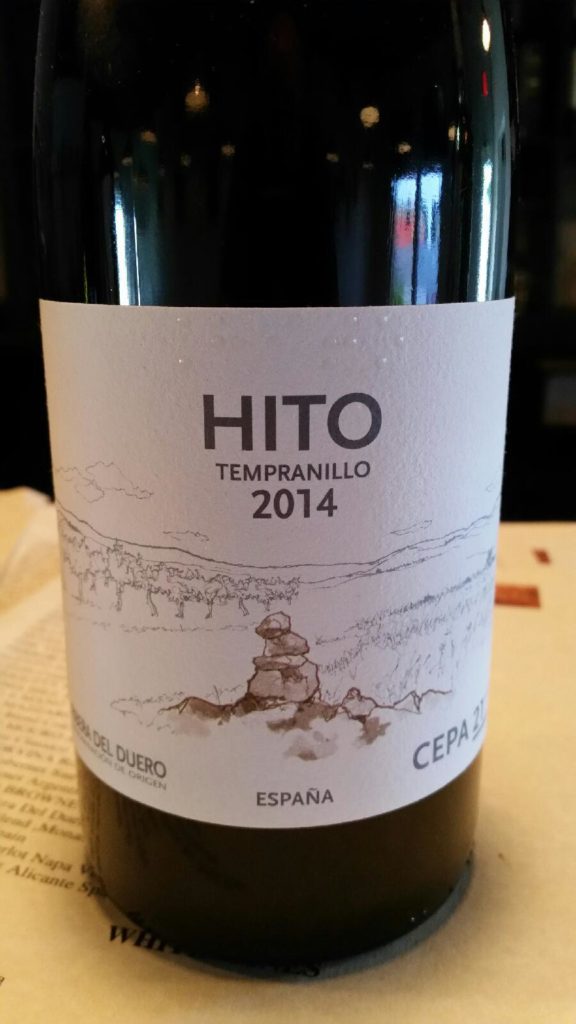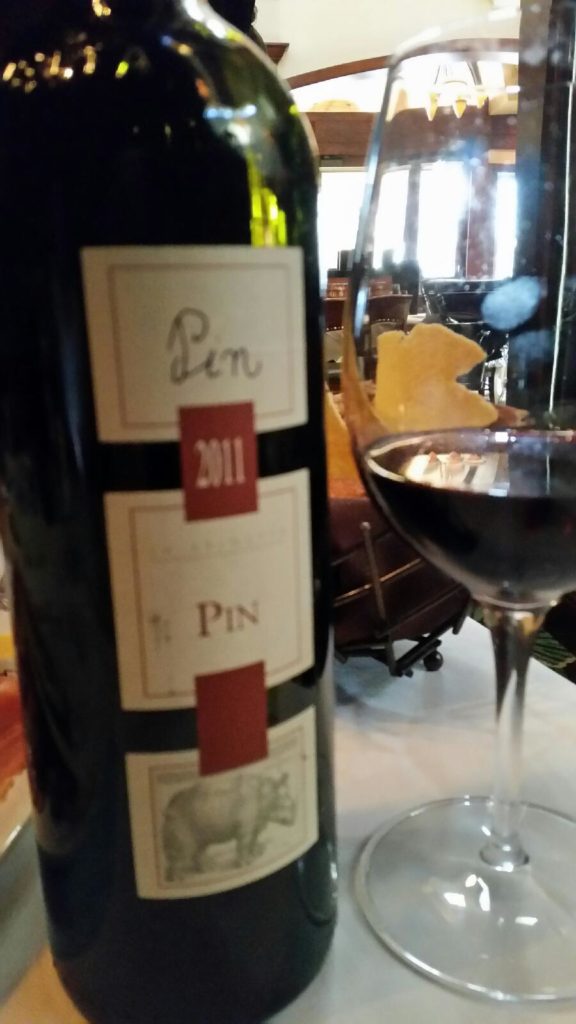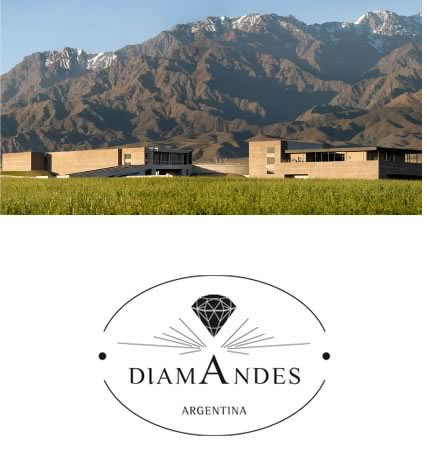What IS volcanic wine, you are probably asking? Here’s the simple definition: Wine made from grapes grown in soil from an active, dormant or extinct volcano. A number of years ago when my husband and I were novice occasional wine drinkers and started attending wine classes, we learned about two basic factors that go into making wine – 1) the terroir of the vineyard and 2) the winemaker who makes the wine. There continues to be disagreement in the wine world over which one claims the most important role. However, since soil plays such a major part of terroir, it came as no surprise to me that volcanic wines deserve special attention. The topic of “volcanic” wines is nothing new — we also learned about the difference in soils during those long ago wine classes and always heard that “volcanic soil” really made a difference to the finished product. After all, you don’t get much more terroir-driven than by a volcano!
That was the extent of my interest in volcanoes……..that is until my husband and I attended an “Explosive Wines” Dinner at Palladio Trattoria, an Italian restaurant in Bonita Springs, Florida. Marcello Palazzi, Regional Manager of The Winebow Group, presented an excellent representation of his company’s volcanic wines which were all paired perfectly with dishes prepared by Chef/Owner Emanuela “Emma” Calcara. Marcello also displayed a book written by Canadian Master Sommelier John Szabo “Volcanic Wines: Salt, Grit and Power”, and gave us a mini-seminar on the  topic as the wines were poured. I found the wines served to be so enjoyable, intense and different from our routinely consumed wines, and the topic so interesting that I knew my next wine research project was about to take shape. And that is how it begins…………. I bought John Szabo’s book, of course, and dove into it with a renewed passion about wine! I’ll try to give you just enough “dirt” to get you to become more interested, read further, and even more importantly to try wines from all of these volcanic parts of the world.
topic as the wines were poured. I found the wines served to be so enjoyable, intense and different from our routinely consumed wines, and the topic so interesting that I knew my next wine research project was about to take shape. And that is how it begins…………. I bought John Szabo’s book, of course, and dove into it with a renewed passion about wine! I’ll try to give you just enough “dirt” to get you to become more interested, read further, and even more importantly to try wines from all of these volcanic parts of the world.
What should you expect when drinking a volcanic wine?
As John Szabo best describes these wines, “they are salty, gritty, and powerful”. Mr. Szabo spent 6 years researching and writing this book which he published in 2016, so he definitely put some effort into his beautiful glossy fact-full tabletop book which I found really fascinating. Here are some basics he presented about the salty, gritty and powerful wines from volcanic soils that appear as a common thread throughout; however, do not lead to any scientific conclusions:
- They have a common mouth-watering quality: sometimes from high acids, sometimes from saltiness and sometimes both.
- Elements of mineral salts are usually involved like potassium, magnesium, calcium, chloride, sulfate and carbonate. This may explain any bitter but pleasant taste.
- Volcanic wines also have a savory character. Their fruity character is usually accompanied by and often dominated by an earthy herbal flavor.
- They usually display a density that comes from the wine extract itself and not the alcohol or tannin. This leads to an intense heavy flavor that can be gritty, salty, hard, unmistakable, and may be considered unpleasant by some people, but not to me.
Some volcano basics
I know you are thinking this information is not of interest to you. I know it isn’t as exciting as reading about a great glass of wine! If so feel free to pass it by, but it does give some helpful insight into the resulting volcano wine regions and the wines that come from them. I’ll try to keep it simple!
What’s a volcano?
A volcano is essentially an opening in the earth’s crust that allows hot gas to escape often spewing out molten or solid rock and ash. The crust is made up of a number of fractured “plates” that sort of drift around like rafts on ocean currents. Most volcanoes form on the edges of these plates which can be moving toward each other (convergent boundaries), past each other (transform boundaries) or drifting apart (divergent boundaries).
There are three main types of volcanism:
- Rifting – Submarine volcanism is the result of forming fissures, cracks or breaks at the edges after drifting apart. New sea crust and undersea mountains are formed. Sometimes these mountains break the surface and form islands like the Azores or Iceland. There can also be continental rifting that can lead to volcanism as in Alsace, France and Pfalz, Germany.
- Subduction – This occurs when the heavier oceanic plate is dragged under the continental plate. The sinking slab can eventually cause an eruption through the weakened continental crust above. A chain or arc of stratovolcanoes forms parallel to the offshore subduction zone such as the Campanian Volcanic Arc, the Cascade Volcanic Arc and the Andean Volcanic Belt. Much of the western edge of North America (Oregon’s coastal hills) is made up of reclaimed oceanic crust.
- Hotspots – These are areas on the earth’s surface above upwellings of unusually fiery molten rock from the mantle, or that part of the earth between the core and the crust. They are found at or near plate boundaries such as in the Azores, the Canary Islands and Hawaii.
What are the types of lava?
- Lava is that hot molten rock generated by a volcano which then solidifies and cools. Lavas are categorized by their amount of silica (silicon dioxide). Silica is found in nature as sand or quartz.
- Basalt lava has a high proportion of iron and magnesium and is characteristically dark in color. Its silica content is relatively low and comprises more than 90% of all volcanic rocks.
- Andesite, dacite and rhyolite are other major types of volcanic rock in order of increasing percentages of silica, potassium and sodium, and decreasing iron and magnesium. This makes rhyolite generally the lightest in color due to high silica content.
- Tephra is the name for all of the materials ejected from a volcano.
- Most volcanoes have a main type of lava which is emitted during an eruption; however just to complicate the makeup of the soil, the composition in the magma (molten or semi-molten rock and solids) below can change in composition.
There are two main types of eruption.
Effusive eruptions are relatively mild, have gentle lava flows and emit mostly basalt lavas. This type eruption has occurred at the Kilauea Volcano on Hawaii and Mt. Haleakala on Maui. Explosive eruptions are by far the scariest! Pliny the Younger was a Roman statesman who described in great detail the horrific volcanic eruption of Vesuvius in 79 AD. Since then, Vesuvius has erupted more than a dozen times. The eruption of December 16, 1631 lasted several days and is one of the 10 deadliest recorded with a death toll of 6,000 people. Mt. Etna killed more than 20,000 people in 1669. Tambora in Indonesia is said to be the deadliest volcanic eruption killing 92,000 people in 1815. Volcanoes are to be feared!!!!
What are the different types of volcanic soil?
Volcanic soil is rich in minerals only found in the center of the earth and has an increased water retention. It is pest and disease resistant and closer to a neutral PH than other soils.
- Lava has a smoky, earthy, savory, salty “taste and texture”.
- Basalt, that common volcanic rock formed from the rapid cooling of basaltic lava, exhibits a rich, clean, round and oily taste and texture.
- Pumice is like a rough textured glass, which may or may not contain crystals. It’s taste and texture exhibit crunch, graphite, earth and dust.
- Tufo (yes, like Greco di Tufo DOCG in Campania, Italy) is a type of rock made from volcanic ash ejected from a vent during an eruption. The taste and texture are ash, savory, compact and gritty. I can honestly say that the delightful bottle of Greco di Tufo we enjoyed with last night’s dinner displayed those characteristics.
There is no universal connection between all volcanic wines and their soils. There are so many different types of soil with so many various compositions that on top of that, have been moved around by rocks, glaciers, wind, water, and people. We DO know that the soil does influence the wine; winelovers and critics have sung the praises of wines from limestone soils for many years. While scientists may still be challenged to explain wine taste and flavors in a relevant way, we winelovers know that the taste and flavors of many wines grown on or near volcanoes are especially good!
Volcanic wine regions of the world
According to John Szabo, volcanic soil accounts for just one percent of the world’s surface, but a lot of it is used for growing grapes, so he had to put some constraints on what regions to study. The result is a list of eight wine growing regions reviewed in his book:
Western hemisphere – The Pacific Northwest, Northern California and Chile
Eastern hemisphere – Macaronesia – Azores, Madeira and the Canary Islands; Alsace; Germany; Italy; Hungary and Santorini.
After reading the book, I quickly decided that I needed to focus on a lot less “dirt” especially if planning to taste through a number of these wines with some adventurous winelover friends. We would need a 2 day seminar to cover that much terroir! So I made a forkandcorkdivine.com decision to stick with volcanic wines of Europe, specifically the Azores, Madeira, Canary Islands, Alsace, France; Germany; Italy and Hungary. Santorini is one of my favorite wine regions, but we have already talked about it in two previous forkandcorkdivine.com articles and tasted on two previous occasions.
Volcanic wine regions of Europe
MACARONESIA: “The fortunate islands”
The Mid-Atlantic Mountain Range is as grand as the Rockies and has formed over many years. It is now the longest submarine mountain chain in the world. Macaronesia refers to the archipelagos of the Azores and Madeira (Portugal) the Canary Islands (Spain) and the island nation of Cape Verde. All of them have formed on top of growing lava mounds that have broken through the ocean’s surface as part of the Mid-Atlantic Range. All of them became wine producers except for Cape Verde as early as the 15th century.
THE AZORES (AҪORES) – Portuguese
The Azores are a sub-tropical nine-island archipelago on the 38th parallel about 1000 miles off the coast of Portugal and see a lot of volcanic action. There is a minor earthquake every day somewhere around the islands and sometimes it’s a major one. There has been 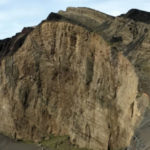 a volcanic eruption every 50 years in the Azores, the last one occurring in 1957. That should surely make life on the Azores very exciting and stressful! Think the life of a winemaker is difficult? Try making wine on the Azores!!!!! That is just what is happening in the three DOPs of the Azores plus smaller quantities on all of the other islands. Very little wine leaves the islands. They have suffered through fungal disease and phylloxera and have an extreme volcanic terroir of barren black basaltic stones. John Szabo described his visit to the island of Terceira and the vineyards of DOP Biscoitos as some of the strangest vineyards he has ever seen. Grape vines need to ward off the strong north Atlantic winds and are grown in squared-off dry
a volcanic eruption every 50 years in the Azores, the last one occurring in 1957. That should surely make life on the Azores very exciting and stressful! Think the life of a winemaker is difficult? Try making wine on the Azores!!!!! That is just what is happening in the three DOPs of the Azores plus smaller quantities on all of the other islands. Very little wine leaves the islands. They have suffered through fungal disease and phylloxera and have an extreme volcanic terroir of barren black basaltic stones. John Szabo described his visit to the island of Terceira and the vineyards of DOP Biscoitos as some of the strangest vineyards he has ever seen. Grape vines need to ward off the strong north Atlantic winds and are grown in squared-off dry 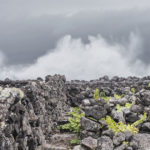
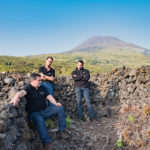 stonewalls called curreletas (or little corrals) made from lump basalt rocks with each square surrounding some wild and bushy vines. The poorer the ground, the smaller the size of the curreleta. And is it ever poor! Most of it is just soil-free crushed rocks. These vines have to really dig deep to come up with any moisture. Pico is dominated by the Volcano Ponto do Pico, Portugal’s highest mountain. Pico is also the youngest island in the Azores at just 300,000 years above the sea, and is the main wine producing island. It actually has to have supplemental soil brought in from neighboring islands. The viticulture here is so unique that it was classified as a UNESCO World Heritage Site in 2004.
stonewalls called curreletas (or little corrals) made from lump basalt rocks with each square surrounding some wild and bushy vines. The poorer the ground, the smaller the size of the curreleta. And is it ever poor! Most of it is just soil-free crushed rocks. These vines have to really dig deep to come up with any moisture. Pico is dominated by the Volcano Ponto do Pico, Portugal’s highest mountain. Pico is also the youngest island in the Azores at just 300,000 years above the sea, and is the main wine producing island. It actually has to have supplemental soil brought in from neighboring islands. The viticulture here is so unique that it was classified as a UNESCO World Heritage Site in 2004.
The Azores Wine Company was established in 2014 and is the best hope for exporting Azorean wines. Azores Wine Company 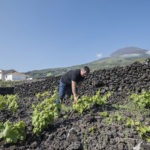 produces a red wine “a Probidia” sourced from old field blend varietals primarily if not entirely made from American grape varietals. The 2014 tech sheets about the wine list the grapes as the Isabella varietal which was planted following phylloxera. Isabella is phylloxera-resistant. It is related to the American “fox grapes” and has an intoxicating savage quality on the nose. According to Filipe Rocha, Founding Partner of the Azores Wine Company, “Proibida is a wine made with grapes from old vines which have a profile that reminds (us of) the ones made from Isabella. It’s our tribute to history and local culture.”
produces a red wine “a Probidia” sourced from old field blend varietals primarily if not entirely made from American grape varietals. The 2014 tech sheets about the wine list the grapes as the Isabella varietal which was planted following phylloxera. Isabella is phylloxera-resistant. It is related to the American “fox grapes” and has an intoxicating savage quality on the nose. According to Filipe Rocha, Founding Partner of the Azores Wine Company, “Proibida is a wine made with grapes from old vines which have a profile that reminds (us of) the ones made from Isabella. It’s our tribute to history and local culture.”
Only 166 cases were made of the 2015 vintage. It no longer names the varietal as Isabella but is described as both “simultaneously delicate and powerful” with food-friendly acidity, profound minerality and terrific concentration. It should be a good pairing for seafood, mushrooms and game.
Three white varietals to know about are Arinto dos Acores, which is the most widely planted and displays an acid and citrus flavor; Verdelho which is aromatic, botanical and fruity and Terrantez do Pico, with herbal, floral, green citrus notes along with mineral salts and seaweed.
MADEIRA – Portuguese
Madeira is part of a multi-isle archipelago and submarine ridge made up of the southernmost tips of a volcanic iceberg 200 leagues under the sea on the Tore underwater mountain range. It is 600 miles from mainland Portugal and 300 miles from Morocco. Madeira Island, one of the only two inhabited islands, is the top of a massive shield volcano with sides of the island dropping sharply into the sea. The volcano last erupted 6500 years ago. A shield volcano has a low profile dome shape due to low viscosity lava spreading out over a large area. Mauna Loa, in Hawaii, is the world’s largest shield volcano.
Madeira is a very popular year-round tourist destination, but it is really famous for the fortified wine grown from grapes on the island and having the same name, Madeira. It’s a 550 year old wine known to all explorers and sailors who ever passed through this part of the Atlantic. It was a favorite of the United States founding fathers. George Washington supposedly drank a pint every night with dinner! Early cocktail parties, called Madeira parties, were common among the well-to-do colonials. Yes indeed, Madeira wine made this tiny little rock world famous!
The basalt bedrock has yielded extremely fertile soils capable of producing three times the average for quality vineyards elsewhere. Narrow green terraces called poios cling to the sides of the hills. Narrow strips of land have to be held in place by dry stonewalls to keep them from washing down to the sea. Vines are grown on a traditional pergola type of system called latada. The height of the pergola ranges from 3 – 6 feet, the higher elevation the pergola, the lower to the ground it is, and all vineyards are tended and harvested by hand. In fact vines grown at 2600 feet are called “vines of the ground”. The main varieties of grapes and styles of Madeira are:
- Sercial – A white grape with a razor-sharp acidity that makes the driest style of wine produced.
- Verdelho – A white grape produced exclusively in a
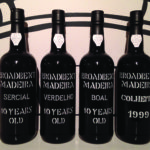 medium-dry style.
medium-dry style. - Terrantez – A white grape highly susceptible to disease and made in medium-dry or sweet style.
- Boal – Bual Branco is produced only in a medium-sweet style.
- Malvasia – Or “Malmsey” is an aromatic white grape brought from Greece and makes the richest sweetest style of Madeira.
- Tinta Negra – The most important grape on Madeira and accounting for 85% of wine produced. It’s the only grape allowed in all of Madeira’s official sweetness categories and used for basic inexpensive Madeiras which includes the light style known as “Rainwater”.
- Rainwater style is said to be the result of accidentally leaving casks out in the rain. The buyer initially complained but found that the customers enjoyed it. And so the Rainwater style became official. Today it is reserved for pale or light-gold colored medium-dry Madeira with an indication of 10 years or less.
Madeira is a relatively neutral, high-acid, low-alcohol type of wine requiring a long time to process. The soils are low in potassium and therefore low in PH and accumulate sugar more slowly. Madeira is also fortified, 17 to 20% alcohol, by the addition of brandy to the fermenting grapes which kills the yeast and inhibits malolactic fermentation. Then the wine is “maderized” or heated and oxidized either in hot attics or specially designed tanks. Unlike wines that mellow with age, Madeira becomes more concentrated and fiery during its long stay in wood. The Madeira Wine Institute strictly controls the entire process from the vineyard to sales, and not a single drop of wine moves without approval of the Institute. Many great Madeiras might have taken 40 years to completion. It can be aged as long as 200 years, and you probably won’t find anything else like it in the wine world.
These are the approved levels of sweetness measured by g/l of sugar left after fermentation:
- Dry or Extra Dry (Seco) – 50-60 g/l – Includes all wines made with Sercial.
- Medium Dry (Meio Seco) – 60-80 g/l – Includes all wines made with Verdelho and some Terrantez.
- Medium Sweet or Medium Rich (Meio Doce) – 80 – 100 g/l – All Boal wines and some Terrantez.
- Sweet or Rich or Full Rice (Doce) – 100+ g/l – All Malvasia wines.
Just to further complicate selecting a bottle of Madeira, you will want to look at the vintage. It can either be a blend of vintages, or a single vintage, but it must be at least three years old.
- Blended – comes with an age designation of anywhere from 5 to over 50 years. And even more confusing, this just means that it displays the characteristics of a wine aged that many years.
- Vintage Date Wine – from a single harvest and can be labeled with that year along with several other identifications!
- Solera – more confusion: a sort of hybrid single-vintage and blended wine. I’ll just leave it at that!
All styles of Madeira have a backbone of acidity and are quite enjoyable on their own but also excellent served with food, the type of food depending upon the sweetness of the Madeira. They are best served in good size white wine glasses so there is plenty of room to swirl. An open bottle of Madeira will last nearly forever! Enjoy.
THE CANARY ISLANDS (ISLAS CANARIAS OR CANARIES) – Spanish
The Canaries are a group of seven major islands located in the Atlantic Ocean 62 miles west of Morocco, Tenerife being the largest. The Canaries are the most tropical of all Europe’s wine regions. All of them are oceanic volcanoes formed by continental drift over a hotspot. The oldest islands came out of the ocean 20 million years ago. Tenerife’s Pico del Teide is the biggest of all the Canary Island volcanos, the tallest mountain in Spain and also the world’s third highest at 12,198 feet. Del Teide last erupted in 1909 but is considered a “Decade Volcano”, or one worth keeping an eye on due to its proximity to populated areas and previous history of destruction.
There are 30 some indigenous grape varietals here that have been untouched by phylloxera for centuries with over 80 varietals growing today and have been unknown by most of us in the modern world until just a few decades ago. The volcanic soils are quite diverse from ash and rich organic matter rock to white ash and clay-sandy soils. The landscape of these islands features scenery different than any other wine region. The vineyards look like something from a science-fiction movie. On Tenerife you will see long braided grape vines tied together with dried banana peels. The island of Lanzarote has extremely unusual views of its treeless, 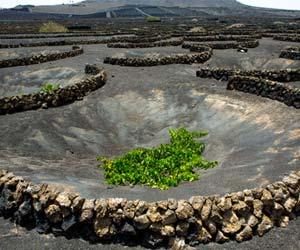 moonlike landscapes with craters and strange rock formations with stiff breezes that are really tough on young grapevines. The
moonlike landscapes with craters and strange rock formations with stiff breezes that are really tough on young grapevines. The 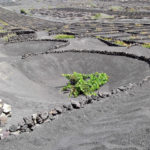 solution is to dig a wide shallow hole in the volcanic black ash soil, plant a vine, then build a semi-circular rock barrier around it. Each hole and wall holds but one grapevine! You may also see camels carrying grapes to the winery! There are 10 separate DOs (wine appellations) in the Canaries with 5 of them on Tenerife. About 250 producers make wine here but only 11 of them make their way into the US. With the recent emergence of modern wines, hopefully there will be more.
solution is to dig a wide shallow hole in the volcanic black ash soil, plant a vine, then build a semi-circular rock barrier around it. Each hole and wall holds but one grapevine! You may also see camels carrying grapes to the winery! There are 10 separate DOs (wine appellations) in the Canaries with 5 of them on Tenerife. About 250 producers make wine here but only 11 of them make their way into the US. With the recent emergence of modern wines, hopefully there will be more.
Listάn Blanco (the Palomino Fino of Sherry) is the most planted white varietal, and exhibits crisp and lively aromatic intensity with lemon-lime and green apple flavors. It is usually made without oak.
Listάn Negro is the most planted red grape. It makes peppery, light, low-tannin wine of modest structure and complexity. It is also known as Criolla in Argentina, País in Chile and was identical to the Mission grape brought to California by Mexican settlers. One example that I plan to taste is an Ignios Origenes Tenerife DO Vcoden Daute Isora from a 30-year old vineyard planted on the iron-rich clay loam of a coastal banana plantation. It is expected to be tart and salty with herbal raspberry and other flavors such as sour cherry, red beets, pepper, iodine and smoky, funky earth.
ALSACE AND GERMANY
Some 400,000 million years ago, in this corner of northeastern France and southwestern Germany, the earth’s crust started to tear apart and crumble. Most of the volcanism ended a long time ago, however there are still some clearly active small pockets. This activity makes for some of the most prized vineyard land in northern Europe. Only a few vineyards are considered volcanic, but their wines have been praised for a thousand years.
ALSACE AND THE RANGEN DE THANN GRAND CRU
About 300 miles due east of Paris you will find the wine region of Alsace, the northernmost wine region in France after Champagne. The winelands of Alsace lie along the western margin of the Upper Rhine Graben, a major rift about 220 miles long and average of 31 miles wide. The Rhine River flows through a trench, the Rhine Rift Valley, which has sunk several miles into the earth’s crust. The French Vosges and German Black Forest Mountains were once united but are now 30 miles apart. The finest grapes grow on the foothills on either side of the valley. Volcanism began here underwater several hundred million years ago. Volcanic cones formed along the way spewed out a mixture of sandstone, granite, limestone and more. The local pink sandstone – gres de Vosges – is a favorite for building cathedrals.
The town of Thann in southern Alsace displays the clearest evidence of volcanism and a single vineyard has reigned supreme for a thousand years –the Rangen de Thann Grand Cru! The Rangenkopf Mountain is 1950 feet high at the southernmost point of Alsace, right over the Vosges Fault Line. Rangen is the only true volcanic terroir in Alsace with soil very poor in organic matter and clay, rich in potassium, phosphorous 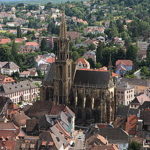 and magnesium and dark grey-brown-black in color. The vines on these 47 acres seem to grow right out of stone on a steep high hillside reaching up to 1500+ feet high. It’s a windy, slow-ripening site able to grow rich and luxurious Riesling and Pinot Gris; Gewurztraminer and Muscat are also grown here. All Rangen wines
and magnesium and dark grey-brown-black in color. The vines on these 47 acres seem to grow right out of stone on a steep high hillside reaching up to 1500+ feet high. It’s a windy, slow-ripening site able to grow rich and luxurious Riesling and Pinot Gris; Gewurztraminer and Muscat are also grown here. All Rangen wines 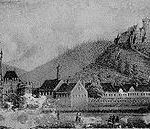 are concentrated, bold, powerful, long, deep, have a great aging capacity and always taste dry. The Rieslings of the Rangen have been found to be consistently higher in ash and the most minerality when compared to other Rieslings. Gunflint, roasted and smoky are terms often used to describe them. The Alsatian winemaker’s goal is to showcase the character of these grapes, and all varietally labeled Alsace AOC must contain 100% of the variety named on the label. There is no doubt these wines display the uniqueness of a single terroir with soils originating from a volcano and are quite possibly the ultimate terroir wine. These are wines that serious winelovers should not miss!
are concentrated, bold, powerful, long, deep, have a great aging capacity and always taste dry. The Rieslings of the Rangen have been found to be consistently higher in ash and the most minerality when compared to other Rieslings. Gunflint, roasted and smoky are terms often used to describe them. The Alsatian winemaker’s goal is to showcase the character of these grapes, and all varietally labeled Alsace AOC must contain 100% of the variety named on the label. There is no doubt these wines display the uniqueness of a single terroir with soils originating from a volcano and are quite possibly the ultimate terroir wine. These are wines that serious winelovers should not miss!
Two of the most highly respected vineyards (or clos) you should definitely know and taste their wines are:
Domaine Zind-Humbrecht’s Clos Saint Urbain: Wines from Zind-Humbrecht’s 12-acre walled vineyard of Clos Saint Urbain 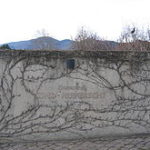 consistently rate in the mid to high 90s. A 2012 Pinot Gris Clos Saint Urbain scored 94 from Robert Parker and 93 Wine Spectator with a description of silky, zesty acidity to balance pineapple, candied coconut and ginger, white peach and grapefruit zest and minerality running throughout.
consistently rate in the mid to high 90s. A 2012 Pinot Gris Clos Saint Urbain scored 94 from Robert Parker and 93 Wine Spectator with a description of silky, zesty acidity to balance pineapple, candied coconut and ginger, white peach and grapefruit zest and minerality running throughout.
Domaine Schoffit’s Clos Saint Theobald: The 16-acre Clos Saint Theobald of Domaine Schoffit produces similarly highly rated wines. Their 94 point 2013 Riesling displays lemon and lime zest notes, is dry, muscular and toned with an almost salty aftertaste.
GERMANY
Up until the twentieth century, Germany and France were the two greatest wine-producing countries in the world. In fact a bottle of German Riesling sold for more than a First Growth Bordeaux and Grand Cru Burgundy. Prices have never returned to that high, but Germany does have a lot of excellent wine to offer—–and much of it is volcanic! Nearly 60% of the world’s Riesling vineyards can be found in Germany, and Riesling is planted in all 13 official regions making it an ideal place to study the differences and similarities created by various bedrocks and soils. Studies completed during an official Viticulture and Oenology and Sensory Evaluation by Dr. Ulrich Fischer at the DLR –Rheinpfalz (a German research center) demonstrated a clear connection between vineyard geology and wine style. Any serious winelover has found this to be true for many centuries, but we are still searching for scientific proof!
These are German wine regions that display a correlation between volcanism, soil and wine style:
Ahr & Mittelrhein: The Eifel Volcanic Field contains over 200 volcanoes in western Germany north of the Mosel River displaying dormant hotspot volcanism. It extends from Belgium and Luxemburg to east of the Rhine River. The last great eruption occurred 12,000 years ago spreading pumice and ash from Sweden to northern Italy. There are still numerous geysers present.
Ahr is one of the smallest (1400 acres) and least known of Germany’s wine regions. Its soils vary between slate, basalt and clay of volcanic origin. Red grapes account for 86% and three-quarters of it is Spätburgunder (Pinot Noir) which is more than any other German wine region.
The Mittelrhein is located in the tourist portion of the Rhine known as the Middle Rhine. This area is a beautiful region of steep terraced vineyards crowned with medieval castles and ruins and was designated as a UNESCO World Heritage site in 2002. The 1100 acres of vineyards are dominated by white grapes, primarily Riesling, and wines here are seldom exported.
Volcanoes in the Mosel are over 280 million years older than the Eifel. The Mosel River loops northward into the Wittlischer Senke marking where the earth was pulled apart along a fault. Slate is plentiful here, sometimes blue-grey and sometimes burnt-orange, but always porous and heat-retaining. There are almost 22,000 acres in Mosel and Riesling reigns supreme. The world famous Dr. Loosen can be found here and the Würzgarten (Spice Garden) Vineyard is renowned. The Bremmer Calmont Vineyard is located in the Mosel and is the steepest vineyard in the world with a 60-70 degree incline.
Nahe & Rheinhessen: The Saar-Naar Senke runs from the Saar River to the Nahe River south of Mosel and represents another area of rifting resulting in volcanic flows 285 – 290 million years ago.
The Nahe is made up of about 10,000 acres of vineyards with 75% white grapes dominated by Riesling. About 500 of these acres are planted on an extraordinary range of volcanic soil which produces some of the regions finest wines. An immense subterranean volcano collapsed around the region of Bad Kreuznach resulting in some spectacular vestiges of volcanism. The region was covered in rhyolitic rock known locally as porphyry. Today most of Nahe wine is consumed domestically or sold directly to consumers. The history of Nahe grapes found them blended with other German grapes and labeled as “Rhine wine”. I remember those jugs of “Rhine wine” in my VERY early days of wine drinking! How about a jug of Carlo Rossi Rhine Wine for $3.95? Much to my surprise, I see it is all still available; however the cost is now $10.99 – inflation at work! Luckily for us winelovers, Nahe makes some of Germany’s most revered wines that are racy and full of flinty-minerality and on the opposite spectrum from that jug wine.
The Rheinhessen is the largest of the 13 German wine regions with 65,000 acres. The volcanic soils of Nahe continue here. Two of the finest vineyards are the warm, shallow Hollberg, and the cool, steep and stony Herrkretz where planting is classified as “a true horror”. White grapes Riesling and Müller-Thurgau account for most of the vineyards, but the red Dornfelder is becoming more important. Rheinhessen is still remembered as the home of Liebfraumilch, a semi-sweet wine that helped to erode the reputation of German wine on the export market. Remember the little Blue Nun? Today quality-oriented top producers in Rheinhessen would not dare to produce that wine.
Pfalz (the Palatinate): The Upper Rhine Graben, lies on the western side of the Upper Rhine Valley. This wine region is situated under the lee of the Palatinate Forest on the Haardt 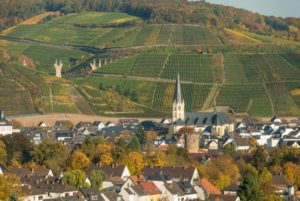 Mountains. Pechsteinkopf is a basaltic volcano above the town of Forst. One of Forst’s most respected vineyards GG Forster Pechstein is named after it. Pech (pitch) and stein (stone) refer to the abundant pitch-black basaltic stones and gives the best description. The Pfalz has become one of the more inventive and exciting wine regions in Germany. There are nearly 20 wineries on the Pechstein and they are all Riesling; however of the 58,000 acres in Pfalz only 24% of it is Riesling. Plantings of red wine varieties such as Spatburgunder (Pinot Noir), Portugieser and Dornfelder continue to increase. Pfalz is a little more southerly and wines here are more “creamy” and less harsh than the northern regions.
Mountains. Pechsteinkopf is a basaltic volcano above the town of Forst. One of Forst’s most respected vineyards GG Forster Pechstein is named after it. Pech (pitch) and stein (stone) refer to the abundant pitch-black basaltic stones and gives the best description. The Pfalz has become one of the more inventive and exciting wine regions in Germany. There are nearly 20 wineries on the Pechstein and they are all Riesling; however of the 58,000 acres in Pfalz only 24% of it is Riesling. Plantings of red wine varieties such as Spatburgunder (Pinot Noir), Portugieser and Dornfelder continue to increase. Pfalz is a little more southerly and wines here are more “creamy” and less harsh than the northern regions.
Dr. Bürklin-Wolf is a 400-year old property and now one of the EU’s largest Biodyvin-certified biodynamic wine estates. They are located in the village of Wachenheim known for its high quality Rieslings. The Bürklin-Wolf Wachenheim 2015 Rieslings are full of fresh green apple and peach aromas with juicy mouth-feel and spice, clean minerality and elegant acidity. They are matured in stainless steel tanks and large oak barrels.
The Friedrich Becker Estate is one of the top Pinot Noir (Spӓtburgunder) producers in Germany. Becker is located almost on the border of Alsace – in fact almost 70% of their vineyards are actually in Alsace. The Beckers produce about 12,000 cases annually. Soil is limestone and one can expect a spicy treat from their estate 2013 Pinot Noir full of strawberry and bright cherry fruit, a hint of tobacco and dusty earthiness and layers of subtle textures.
Baden, the “Black Forest” area, is Germany’s southernmost wine region and is home to the Kaiserstuhl Volcanic Complex which rises atop the junction of two major faults where periodic eruptions occurred from 18 million to 16 million years ago. Soils range from granite, gravel, limestone and clay to loess and volcanic stone. This is Germany’s warmest location; therefore its wines are usually more full-bodied and higher in alcohol than other German wine regions. The Pinot family is now challenging Riesling with almost 55% of the vineyards planted in pinot varietals (23% Spätburgunder/ Pinot Noir).
German wine classifications can be extremely confusing. In addition to regions and internal smaller regions, wines can be made at six levels of ripeness which you may see on the label:
- Kabinett: Typically light-bodied, low in alcohol and usually dry or off-dry.
- Spatlese: Grapes are harvested later than kabinett, may be dry or off-dry with greater fruit intensity and fuller body.
- Auslese: Made from very ripe grapes harvested in bunches, lush and often fairly sweet.
- Beerenauslese: Made from very ripe individual hand selected grapes, affected by noble rot, with deep honeyed richness and always sweet.
- Trockenbeerenauslese: The richest, sweetest, rarest and most expensive of all German wines; enormously concentrated and exquisitely balanced.
- Eiswein: Made from very ripe, frozen grapes; high in both sweetness and acidity. Must be naturally frozen on the vine as opposed to commercial freezing in other countries.
And then there is the level of sweetness categories:
- Trocken: bone dry; less than .9% residual sugar.
- Halbtrocken: half dry; less than 1.8% residual sugar.
- Lieblich or mild: some sweetness; up to 4.5% residual sugar.
Germany is considered one of the world’s top producers of elegant white wines. Of the nearly 60 grapes grown, Riesling is the most prestigious. Yes, the German wine organization and labeling systems are complicated; however, these highly acidic, very fresh and crisp wines with their origins in volcanic soil are not to be ignored!
HUNGARY THE BAKONY-BALATON HIGHLANDS VOLCANIC FIELD & THE ZEMPLÉN HILLS
Modern Hungary is a small country in the middle of Eastern Europe bordered by Slovakia, Ukraine, Romania, Croatia, Serbia, Slovenia and Austria, and was once one of the most powerful forces in the world. There are 22 wine regions in Hungary, and you don’t need to travel far to find volcanic rocks. There are arcs of volcanoes running parallel to a subduction zone of the Intra-Carpathian plate and other isolated volcano cones here and there. There are dozens of mineral springs and thermal pools in the countryside; all reminders of volcanic activity a couple million years ago. There are now so many hot springs, spas and wellness hotels that Hungarians call themselves a “spa superpower”.
Hungary has a long history and culture of winemaking and unique varietals. Vineyards have been thriving at least since Roman times. When the Magyars arrived from the Ural Mountains in the ninth century, they brought a language which is one of the few in Europe that does not belong to the Indo-European language family. Hungarian is definitely a difficult language! In the seventeenth century, the extraordinary wine Tokaji Aszu (TOKE-eye ah-SOO) put Hungary on the international wine map. It is still one of the world’s greatest dessert wines to this day. For most of the modern era Hungarian wines weren’t known outside of the Soviet Union and other Communist countries. Hungary was under Communist rule for 40 years.
There are twenty-two wine regions and each of them has their own unique character. The wines have been described as “colorful” and varied. There are a number of indigenous white varieties with late ripening, distinctive, aromatic fruit and floral scents and some bold red varieties. They are also fully bodied, rich in minerals due to their volcanic soils. Wine regions that you should know are: Tokaj-Hegyalja, by far the most prestigious, Somlό, Badacsony, Szekszάrd, Villάny-Siklόs, Eger and Mάtra.
Four of Hungary’s finest volcanic regions are: Tokaj-Hegyalja, Badascony, Balaton-felvidek (Bakony-Balaton Highlands) and Somlό.
Bakony-Balaton Highlands Volcanic Field is home to over 50 eruptive centers. These trapezoidal-shaped volcanic flat-topped hills are the result of volcanic activity that began 7.5 million years ago and lasted for 5 million years. The remainders of all this activity left strange formations around the northern shores of Lake Balaton where vines now grow. Further north the volcanos of Somlό share the same genetics featuring eroded volcanic necks of columnar basalt or “organ pipes”.
Badascony (bah-dah-choin) and Balaton-felvidέk, on the north shore of Lake Balaton, are two of the 22 official wine regions. The landscape is beautiful and much of the area is now protected by the Balaton-felvidέk National Park. Balaton-felvidέk is a relative large appellation with the separate appellation of Badascony within it. Vineyards cover these volcanic “hegy” or hills in Hungarian. Lake Balaton is a remnant of the ancient Pannonian Sea which covered most of Hungary until about 5.5 million years ago.
Distance to the lake makes many differences based on humidity and temperatures. And then there are many differences in the soil between all those volcanoes making it a lot for winemakers to understand and make the best of.
Badascony produces primarily white wines – Chardonnay, Sauvignon Blanc, Szürkebarάt (pinot gris), and Olasz Rizling (Welschriesling in Austria and Graševina in Croatia); however red grapes are permitted and grown. Kέknyelű or “Blue Stocked” is utterly unique to this region and named for the color of its stems. It makes a smoky, flinty, honeyed floral wine with sizzling acids, salty taste and almost chewable extracts.
Somlό (shown-low), nicknamed Witness Mountain, is one of the smallest, most beautiful and most remote regions specializing in traditional wood-aged powerful dense white wines – Furmint, Hάrslevelὔ, and Juhfark. Just a bit of trivia: the Hapsburgs believed that drinking Juhfark, or sheep’s tail, guaranteed that a pregnant woman give birth to a boy. Then there is Nάszέjszakάk Bora, the “wedding night wine” of Somlό which “guarantees” the birth of a boy. And by remote, I mean few paved roads or limited electricity! This is Hungary’s smallest appellation and most of the vineyards sit on Somlό-hegy (Somlό Hill), a single truncated volcanic cone. Somlo is the only region that grows any major amount of Juhfark which is considered a blue-collar grape and needing time and oxygen to make it drinkable. Furmint gives a complex array of savory and botanical notes with screaming stony non-fruit flavors. Hάrslevelű is softer and more aromatic but still mineral in character. The best of these wines is usually fermented in 500 liter casks and can age for decades. 
The Somlόi Apάtsάgi Pincέszet, originally owned by the Benedictine Pannonhalma Archabbey, was expropriated and redistributed during Communism. In 2001 Zoltan Balogh, grandson of a previous 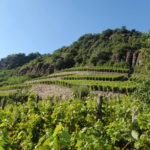 winemaker, bought it and brought it back to life. It is planted in Furmint, Juhfark, Hάrslevelű and Olaszrizling. The Hάrslevelű grapes are low cordon trained and dry farmed without herbicides or pesticides in a mixture of clay, sand and basalt. The grapes are late harvested, handpicked for extreme ripeness, fermented and aged in oak, then bottled unfiltered. Balogh believes his grapes need to fully express the terroir. The 2015 Hάrslevelű wine is oily, concentrated, bright and powerful without losing fruitiness. It is rich and sweet in notes of pineapple, pear and strawberry while firm and savory at the same time.
winemaker, bought it and brought it back to life. It is planted in Furmint, Juhfark, Hάrslevelű and Olaszrizling. The Hάrslevelű grapes are low cordon trained and dry farmed without herbicides or pesticides in a mixture of clay, sand and basalt. The grapes are late harvested, handpicked for extreme ripeness, fermented and aged in oak, then bottled unfiltered. Balogh believes his grapes need to fully express the terroir. The 2015 Hάrslevelű wine is oily, concentrated, bright and powerful without losing fruitiness. It is rich and sweet in notes of pineapple, pear and strawberry while firm and savory at the same time.
Stephan (Istvάn) Spiegelberg was a German DJ and BMW test car driver in his previous life. In 1993, he left Germany and bought 2 hectares of vines plus a small home without running water or electricity in Somlό. He began bottling wines in 2004. Spiegelberg Artisan Winery cellars and production are the smallest in Hungary and he works everything by hand making some “classic” Somlό wines but mainly quirky artisanal wines. After hand harvesting and sorting, his grapes go into Hungarian oak barrels for fermentation and continuing barrel aging for 12-16 months to the sounds of Gregorian chamber music. Spiegelberg’s wines are heady, dense, and gripping with smoky minerality and brininess. You can read a first-hand account of a visit to Spiegelberg Winery by googling a blogpost “Stephan Spiegelberg’s passion & candles reveal a special wine site” at hobberdogchronicles.royhobbs.co. Our local winelovers, Tom and Ellen Giffen visited Spiegelberg in 2016 and tell you all about their amazing experience.
The 2011 Spiegelberg Wedding Night Wine is a blend of Juhfark, Hάrslevelű and Furmint blending fruit, flowers, orange blossom aromatics, salt and smoke in one bottle! 2230 bottles were produced.
The Tornai Pincέszet historic estate was founded in 1946 by Endre Tornai, who was among the first to bottle wine commercially from Somlό in 1984, and is now one of the two largest in Somlό. He started out on a one acre vineyard and now owns 56 planted in the usual Somlό varietals. There is special emphasis on agro-technical and biological protection. Juhfark Premium is Tornai’s flagship wine macerated and aged in a blend of stainless steel and oak. The 2015 Tornai Juhfark Premium shows overripe aromas on the nose, underlined by stony notes. It is very complex on the palate with a vibrant and round acidity.
On a previous occasion, I have also enjoyed a Kreinbacher Brut Classic Sparkling wine from Somlό made of Furmint and Chardonnay which won a gold medal at the 2016 Champagne and Sparkling Wine World Championship.
The Zemplέn Hills rise up above Hungary’s Great Plain on the other side of the country in the northeastern corner. They are near a subduction zone related to the formation of the Carpathian Mountains along a volcanic arc that stretches from Budapest to the northeast tip of Hungary. There are all sorts of signs of volcanic action here including multiple deep layers of various rocks, ash, and tephra. The region is also known for hot springs and geysers.
Tokaj-Hegyάlja is the wine region that covers the foot of the Zemplέn Hills. It is named after the town of Tokaj which sits at the foot of Tokaj-hegy or Bald Mountain, the region’s tallest volcanic remnant at 1680 feet. This is home to Tokaji Aszú, Hungary’s most famous wine, which is made from botrytized grapes, and they’ve been making it for at least 500 years. In the 18th century, it was the most highly-prized and sought-after wine in the world, pronounced by Louis XIV as the “Wine of Kings and King of Wines”. The exceptional terroir, volcanic soils, miles of underground wine cellars, and centuries-old wine making traditions all helped the region to become UNESCO designated on its list of World Heritage Cultural Landscapes in 2002. Soils are complex with the most important type called nyirok, a heavy clay from volcanic rock ranging in color from reddish to brown or black. Grapes primarily used now are Furmint and Hάrslevelű .
Tokaju Aszú is one of the world’s most multi-dimensional wines. It has extreme high levels of sugar, extract and acid with astonishing flavor complexity and is one of the most decadent but-well-balanced sweet wines in the world. The wine is made by soaking individually hand-picked, botrytis-affected berries (aszú) in a base of fresh grape must or wine for a few hours up to a few days, then pressing, re-fermenting and ageing at least 18 months in wood. Sweetness is measured in puttonyos.
3 puttonyos – 6-9% residual sugar
4 puttonyos – 9-12% residual sugar (Equivalent to a French Sauterne)
(Note: 3 and 4 were legally abolished in 2014, but they are still on the market.)
5 puttonyos – 12-15 % residual sugar
6 puttonyos – 15-18% residual sugar
Tokaji Aszú Esszencia – 18-45% residual sugar
Tokaji Esszencia – 45-90% residual sugar
Tokaji Aszú is meant to be drunk in a 2-ounce serving (or less!) and should always be lightly chilled. There is no need to age it further and upon opening can be kept in the refrigerator for months. It is traditionally served with Hungarian celebratory desserts or else paired with foie gras or Roquefort or Stilton cheese.
The three main white grapes used in Tokaji are Furmint, Hάrslevelű, and Sάrga Muskotάly, also known as Muscat Blanc a Petits Grains. Since the 1990s, Zeta (formerly called Orέmus), Kövέrszőlő and Kabar are also permitted. The wine must be aged for at least three years in oak barrels and is always bottled in the traditional squat 500 ml Tokaji Aszú bottles.
Orέmus has been owned by the Alvarez family since 1993. Alvarez also owns Spain’s most famous estate, Vega-Sicilia. They began an 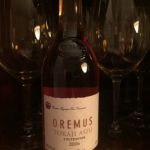 ambitious restoration plan, built a modern production facility and invested heavily in vineyards making Orέmus now one of the most reliable and consistent estates producing 375,000 bottles per year of which 80,000 are Aszu. The 5 Puttonyos is usually a rich, gold color. The complex nose features caramel, dried fruits especially raisins and dried apricots, lemon peel, spice and brown sugar. It is sweet on the palate, with great balancing acidity crammed with layers of ripe fruit. It has a fresh, clean finish and very long length.
ambitious restoration plan, built a modern production facility and invested heavily in vineyards making Orέmus now one of the most reliable and consistent estates producing 375,000 bottles per year of which 80,000 are Aszu. The 5 Puttonyos is usually a rich, gold color. The complex nose features caramel, dried fruits especially raisins and dried apricots, lemon peel, spice and brown sugar. It is sweet on the palate, with great balancing acidity crammed with layers of ripe fruit. It has a fresh, clean finish and very long length.
The 2006 Orέmus Vega Sicilia Tokaji Aszú 5 Puttonyos has been rated 95 pts by Robert Parker. Specific Wine Enthusiast tasting notes include heady aromas of gardenia, white flowers, freesia, honey and dried apricots; full bodied in the mouth with flavors of caramelized pineapple, apricot nectar and lemon curd.
One of the biggest changes since the communist era is the making of dry Tokaji wines. Until the 2000s dry Tokaji was usually an afterthought. Now such high-quality dry Furmint wine is setting Tokaji on a new path.
The 2015 Bott Csontos Furmint from Tokaj is 100% Furmint macerated and aged in Hungarian oak. It was produced by Jόzsef and Judit Bodό, both from a Hungarian ethnic region in Slovakia. Following their dream to produce wine in Tokaj, they found Csontos and in 2005 bottled their first vintage of “Bott”, Judit’s maiden name, from 1 hectare. Today they tend 5 hectares all from indigenous varietals. Csontos means “strong boned” and the vineyard is red clay and volcanic soils planted right on the edge of the Zemplen forest. The soil is still tilled by horses and the family uses an antique wooden press and a medieval looking bladder press from the 60s. Wines are fermented slowly in mostly used oak barrels with native yeast over 6-8 weeks. They then remain in the barrel between 7-10 months and remain true to place. Critics gave it an average score of 90 points.
In recent years the individual wine regions have started some serious planning to showcase and promote their wines. Organic winemaking and sustainability has become very important. There are wine festivals in the main cities welcoming tourists, journalists and bloggers. Outstanding red wines are being promoted – the “Franc and Franc” conference helps to promote outstanding Cabernet Franc to the international market. Kέkfrankos (Blaufrӓnkisch) is an outstanding indigenous red becoming increasingly capable of competing with the best wines of elsewhere.
Wine culture is spreading, the selection of quality wines at affordable prices is increasing, consumption of sparkling wine is once again popular, the variety is set to expand further, and premium wines are available and will see growing demand among more sophisticated consumers. This small country of Hungary, hardly known for anything else than the head-achingly communist style wines from the Cold War era and its world-class sweet Tokaji wines, warranted 47 pages in John Szabo’s book. In total, 44 of its wineries were found good enough to get a detailed introduction by Mr. Szabo. As one Hungarian said, they have “tasty rocks”! Hungarian wine is definitely on the rise. I think it rocks! Please give it a try.
ITALY AT THE MARGINS OF EURASIA & AFRICA
Italy is already so worthy of wine discussion due to the prolific amounts of highly rated wines produced there, that it is hard to think we can come up with any additional reasons to drink more Italian wine, but believe it or not it is also one of the world’s most volcanically active wine regions. The only active volcanoes in mainland Europe are in Italy. In fact the Island of Vulcano- the origin of the word volcano – is here in Italy. The endless crunching, scraping and subducting of the Eurasian and Teutonic plates has pushed up the Alps and Apennines and caused a chain of volcanism of every kind from Soave to Sicily. Some volcanoes have been extinct for a very long time while others are alarmingly active. Without them, Italy’s wine would be quite different. For this article, we are just going to discuss a few of the volcanic regions starting with Mount Etna in Sicily , moving north to Basilicata, then on to Campania and last but not least, Soave. So let’s get ready to rumble!
MOUNT ETNA, SICILY
Mount Etna rises up like an island on an island, known by the Sicilians as “Mongibello” meaning mountain mountain in two different languages. Etna is a classic stratovolcano built over the last 600,000 years now reaching 10,990 feet above the sea. It is one of the world’s most active volcanoes and is still growing. It has several eruption centers plus hundreds of minor cones and vents. Add that to the list of winemaker concerns! The rocky perilous slopes are already difficult and expensive to farm.
The main white grape on Etna is Carricante which is defined by stony flavors and salinity. The chief red is Nerello Mascalese which features high acids and significant tannins, full of wild strawberry, sour cherry and currants with plenty of savory herbal and tobacco notes. Its companion grape is Nerello Cappuccio which is slightly lower in tannin and deeper in color.
The Etna DOC grows in a semi-circle around the volcano only excluding the west flank. Vines grow from 1150 feet rising up to 3300 feet. Terraces are necessary to keep the vineyards from falling down the hillsides. The higher up the hillside, the deeper the volcanic soil. The exact makeup of the soil varies all around and up and down the hillsides, but it is all volcanic in origin.
Etna Bianco is made predominately from Carricante (minimum 60% by law). Etna Rosso is made from the Nerello Mascalese (80% minimum) with the possible addition of Nerello Cappuccio.
Tenuta di Fessina has two lava flows that wrap around the property ensuring a feared and respected relationship with Mt. Etna. “Erse” Etna Bianco DOC is a white blend made up of 80% Carricante, 20% Catarratto and Minnella. The grapes grow in lava stones, volcanic ash and sandy loam between 2900-3300 ft up the hillside. The wine has a savory salinity with notes of pear and hay with a long textural finish. “Erse” Etna Rosso DOC is 80% Nerello Mascalese and 20% Nerello Cappuccio. These bush trained vines grow slightly lower down the hill at 2200 ft in lava stones, volcanic ash and sandy loam. You can expect aromas of crushed berries, plums and smoky minerality plus some chalky dusty dryness really requiring a food accompaniment. The Fessina winemaker Federico Curtaz worked with Angelo Gaja for two decades. Erse is an excellent regional representative from younger vines.
Sicily itself is Italy’s largest region at 10,000 square miles and outside of Etna is known for the red grape variety Nero d’Avola. Just 62 miles southwest of Sicily is the small active volcanic island of Pantelleria, a satellite island of Sicily and part of the same volcanic chain. Pantelleria is famous for its moscato passito di Pantelleria, made from Zibibbo grapes. Zibibbo grapes are the oldest continually existing unmodified grape still in vinification and are also known as Muscat of Alexandria. Part of the moscato is harvested when ripe, pressed and juice set aside but the remaining moscato grapes are laid on mats and dried in the sun until shriveled into supersweet raisins. These juices are then blended and fermented together. The result is a neon-orange passito dessert wine.
Donnafugata Passito di Pantelleria Ben Ryέ (Ben Ree-ay) is an international icon for Italian dessert wines. It is produced on Pantelleria in volcanic sandy soil originating from lava. The low 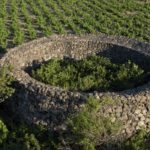 bush vines of Pantelleria have been inscribed on the UNESCO World Heritage List as a “creative and sustainable practice”.
bush vines of Pantelleria have been inscribed on the UNESCO World Heritage List as a “creative and sustainable practice”. 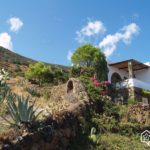 Tasting notes describe the 2014 Ben Ryέ as brilliant amber with freshness and complexity. The bouquet is intense and fragrant: typical aromas of apricots and candied citrus zest combined with balsamic scents of Mediterranean scrub and sweet notes of honey and fresh figs. The palate is well defined and intense, with pleasant sweetness well balanced by a fresh vein of acidity and lively sapidity. Serve it in tulip-shaped goblets of medium size, slightly bellied; uncork at time of serving; 57 degrees. Ben Rye comes from the Arabic term “Son of the Wind”. 95 pts Robert Parker; 93 pts Wine Enthusiast & WS.
Tasting notes describe the 2014 Ben Ryέ as brilliant amber with freshness and complexity. The bouquet is intense and fragrant: typical aromas of apricots and candied citrus zest combined with balsamic scents of Mediterranean scrub and sweet notes of honey and fresh figs. The palate is well defined and intense, with pleasant sweetness well balanced by a fresh vein of acidity and lively sapidity. Serve it in tulip-shaped goblets of medium size, slightly bellied; uncork at time of serving; 57 degrees. Ben Rye comes from the Arabic term “Son of the Wind”. 95 pts Robert Parker; 93 pts Wine Enthusiast & WS.
BASILICATA
Monte Vulture (VOOL- too-reh), an extinct stratovolcano with black basalt soils, stands at 4350 feet just across the eastern border of Campania in the region of Basilicata. It’s the only volcano in Italy on the east side of the Apennines. The important wine appellation in Basilicata is the Aglianico del Vulture DOCG. 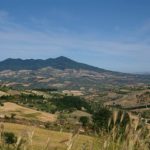 Vulture began to erupt about one million years ago, but last erupted 40,000 years ago. Earthquakes have also devastated much of the region. Basilicata has two coastlines, one on the Tyrrhennian Sea between Campania and Calabria, and a longer coastline between Calabria and Apulia. If you think of Calabria as the “toe” of Italy and Apulia the “heel”, then Basilicata is the “instep”. Time stands still in Basilicata. It is mostly agricultural with shepherds tending flocks of sheep and cattle, single lane country roads and unpaved dirt tracks. Its Italy’s sparsest populated region, and you may travel for miles without seeing anyone else.
Vulture began to erupt about one million years ago, but last erupted 40,000 years ago. Earthquakes have also devastated much of the region. Basilicata has two coastlines, one on the Tyrrhennian Sea between Campania and Calabria, and a longer coastline between Calabria and Apulia. If you think of Calabria as the “toe” of Italy and Apulia the “heel”, then Basilicata is the “instep”. Time stands still in Basilicata. It is mostly agricultural with shepherds tending flocks of sheep and cattle, single lane country roads and unpaved dirt tracks. Its Italy’s sparsest populated region, and you may travel for miles without seeing anyone else.
Aglianico (alli-yawn-nico) is the only permitted grape variety here and the vines are grown on the traditional vine-trellising method called vigna a capanno, introduced by Albanian immigrants in the 15th century. Three posts are tied together like a tripod over a single vine. One post is fixed but the other two are moveable. The moveable part of the tripod is shifted up to four times during the growing season so that grapes are shaded from the sun and lessen damage from the fierce winds. Aglianico is full-bodied and known for savory flavors of leather, white pepper, black fruits and cured meat, most definitely a wine of its terroir. You can almost imagine smoke, ash, cedar, cigar box, and game when you taste it. Traditional Aglianico is best after 10 or more years of age and has been nicknamed the “Barolo of the South”. Wine styles differ so dramatically the further away you get from Vulture that some producers have proposed creating an Upper Vulture sub-zone. Of course the “true” Aglianico del Vulture DOCG wines come from the highest elevations.
Bisceglia 2012 Gudarrà Aglianico del Vulture comes from 1300 feet up the east side of the Apennine Mountain range on the slopes of Mount Vulture and vines grow in tufo and basalt volcanic soil. The Bisceglia estate is in the historic district of Lavello. 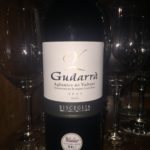 Gudarrà, in local dialect means “to be enjoyed”. It is 100% Aglianico, deep ruby-red in color with violet hues and gives you a weighty ashy mouthfeel texture and notes of savory tomato compote. Expect Mediterranean herbs, black-skinned berries, and baking spice aromas with anise, ground pepper, and dried black cherries on the palate. Tannins are aggressive and gripping. WS gave it 90 pts.
Gudarrà, in local dialect means “to be enjoyed”. It is 100% Aglianico, deep ruby-red in color with violet hues and gives you a weighty ashy mouthfeel texture and notes of savory tomato compote. Expect Mediterranean herbs, black-skinned berries, and baking spice aromas with anise, ground pepper, and dried black cherries on the palate. Tannins are aggressive and gripping. WS gave it 90 pts.
CAMPANIA
Campania is located in the Southern Italian Peninsula moving north from the toe, heel and ankle of the Italian boot. It borders on the Mediterranean Sea on the west and is best known for Naples, the Amalfi Coast and the Isle of Capri.
The soils in every area of Campania have been influenced by volcanism. The regular eruptions of nearby Lipari Island, the Campi Flegrei, Roccamonfina, Monte Vulture and Vesuvius have all contributed to the ash and tephra enriched soils of the entire 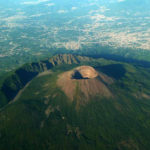 region. Mount Vesuvius, the most famous, is a 4203 foot high stratovolcano that can be seen from every angle in the Bay of Naples. It’s just 25,000 years old! Vesuvius eruptions have been fairly cyclical and volcanologists predict the next major eruption sometime in the next 500 years. Considering that three million people live nearby, it has earned the title of the world’s most dangerous volcano. Camp Flegrei is a large highly active area on the opposite side of Naples with five volcanic lakes and up to ninety volcanic cones and craters that have erupted during the past 37,000 years. The ground in this area is known to heave and swell up by several inches in a day and even feet during a year. Roccamonfina is Campania’s only extinct stratovolcano, active from 650,000 to 50,000 years ago and is located in the northwest corner of the region.
region. Mount Vesuvius, the most famous, is a 4203 foot high stratovolcano that can be seen from every angle in the Bay of Naples. It’s just 25,000 years old! Vesuvius eruptions have been fairly cyclical and volcanologists predict the next major eruption sometime in the next 500 years. Considering that three million people live nearby, it has earned the title of the world’s most dangerous volcano. Camp Flegrei is a large highly active area on the opposite side of Naples with five volcanic lakes and up to ninety volcanic cones and craters that have erupted during the past 37,000 years. The ground in this area is known to heave and swell up by several inches in a day and even feet during a year. Roccamonfina is Campania’s only extinct stratovolcano, active from 650,000 to 50,000 years ago and is located in the northwest corner of the region.
Campania has a rich tradition in gastronomy and wine with over 100 grape varietals and more than 100 wineries. It is such a happy place that the Romans referred to it as Campania Felix or “happy country”. Unfortunately a devastating earthquake rocked the province of Avellino in 1980. An entire generation of the area residents fled leaving behind many ancient vineyards that remained as they were 200 years ago. Instead of replanting with “newer” varietals like the rest of the country, they are now making wine just like it was 200 years ago. In 2016, Campania produced 14 million cases of wine but most of it was table wine with only 19% at the DOP level.
Falanghina, the most planted white, is usually fresh and unoaked. Fiano is the greatest white and is prominent in the Fiano di Avellino DOCG. The Fiano and Greco di Tufo were the first whites to be granted top classification in southern Italy. Antonio Mastroberardino, considered by many as the patriarch of wine in Campania, is credited with returning Fiano to its current status. Fiano is distinctly non-fruity, but with a mix of fennel and fresh herbs, hazelnuts and honey, chamomile and acacia flowers, growing more toasty and smoky with time. Greco was transported here by the Greeks and is difficult to grow. It is even less fruity – with high acids and alcohol, quite tannic. It may be called the “most red of white wines”. The town of Tufo is on top of volcanic-derived sulphur that is responsible for the wine’s flinty and stony character. Coda di Volpe (or fox’s tail) is generally soft, fruity and easy drinking. It is naturally high in acid delivering marked saline-mineral character and even a touch of petrol. Aglianico is Campania’s main red grape and is the backbone of Aglianico del Taburno and Taurasi, the region’s only red DOCG appellations. Just as Aglianico in Basilicata, it is dry and austere with aromas of leather, tobacco, tar, and sun-warmed terra cotta. Piedirosso is the next most planted red grape and said to be “the most difficult variety in the world”. Most vintners complain of the lack of color and structure.
Campania is made up of five provinces and here are some of the most important volcanic-influenced zones. Benevento produces over half of the Campanian total but bottled wine is a new thing here. This area has regularly received volcanic fallout from nearby eruptions for eons. Most of Falanghina originates here and the Sannio Falanghina DOC is a very good example. Avellino produces strikingly fresh whites and two of the three DOCG appellations are whites – Fiano di Avellino and Greco di Tufo. Avellino’s top red is the Aglianico-based Taurasi DOCG. Napoli is primarily urban and industrial, but there are still some producers in the suburbs. Vesuvio DOC and its Lacryma Christi del Vesuvio Bianco/Rosso sub-categories are Napoli’s other important appellations, produced on all sides of Mount Vesuvius.
Caserta is the northernmost province on the Lazio border. Falernum was the most important wine in ancient Rome and it came from the vineyards on volcanic ash over limestone soil in the hills north of Roccamonfina. It was a cult wine for the rich and famous of its time, often mentioned in Roman literature. Falernian was either red or white wine with 15-16% alcohol. It was late-harvested, then aged for 15-20 years in clay amphorae. Falerno del Massico DOC is the modern Falernum with whites from Falanghina. Galluccio DOC is the other appellation in the foothills of Roccamonfina. Roccamonfina IGP is a protected geographical area in Caserta.
Mastroberardino has been a registered wine estate since 1878 with a wine-growing history dating back to 1760. They made the decision to champion Campania’s indigenous varietals instead of going more in the French direction, propagating priceless genetic material from the ancient vines and encouraging many smaller wine-growers to do the same. Today they are a regional leader with appellations in Avellino, Benevento and Vesuvius.
2016 Mastroberardino Falanghino del Sannio DOC is made from 100% Falanghina and is named after falangae, Latin for supporting stakes, and may well be the basis for the legendary 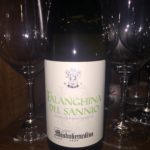 Falernian wine. It is grown 1,155 feet altitude in volcanic sandy loam in the espalier style with Guyot training and aged in stainless steel tanks. It is pale lemon-green in color with aromas of ripe pineapples and citrus fruits complemented by undertones of white flowers. On the palate, zesty acidity and persistent notes of honeysuckle and toasted almond.
Falernian wine. It is grown 1,155 feet altitude in volcanic sandy loam in the espalier style with Guyot training and aged in stainless steel tanks. It is pale lemon-green in color with aromas of ripe pineapples and citrus fruits complemented by undertones of white flowers. On the palate, zesty acidity and persistent notes of honeysuckle and toasted almond.
2016 Mastroberardino Lacryma Christi del Vesuvio  Bianco DOC is made from 100% Coda di Volpe grapes grown at 560 feet on Mt. Vesuvius in layers of volcanic ash composed of pumice, pyroclastic debris and clay loam. It tastes of dusty stone and daphne flower blossoms with a gritty mouth feel.
Bianco DOC is made from 100% Coda di Volpe grapes grown at 560 feet on Mt. Vesuvius in layers of volcanic ash composed of pumice, pyroclastic debris and clay loam. It tastes of dusty stone and daphne flower blossoms with a gritty mouth feel.
Lacryma Christi, (tears of Christ) are said to have been shed by Christ either because the Bay of Naples was so beautiful or because when Lucifer fell from heaven, Christ was sad and cried tears that landed on the slopes of Mount Vesuvius producing the miraculous vines.
2014 Fattoria Galardi Terra di Lavoro Roccamonfina IGT comes from 1485 foot high Roccamonfina volcanic slopes and is 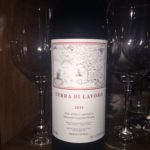 80% Aglianico and 20% Piedirosso. The Galardi family produces just this one wine! Terra di Lavoro means “land of work” and is it a challenging environment. The soil is grey tufo with pyroclastic flow deposits of pumice and fine ash. The wine is deep purple with smoky, earthy aromas and hints of tobacco and graphite. Notes of ripe black cherries, cassis, tobacco and leather come through on the palate. It also has mineral notes similar to crunchy graphite.
80% Aglianico and 20% Piedirosso. The Galardi family produces just this one wine! Terra di Lavoro means “land of work” and is it a challenging environment. The soil is grey tufo with pyroclastic flow deposits of pumice and fine ash. The wine is deep purple with smoky, earthy aromas and hints of tobacco and graphite. Notes of ripe black cherries, cassis, tobacco and leather come through on the palate. It also has mineral notes similar to crunchy graphite.
SOAVE
The name “Soave” (So-Ah-Ve) represents a number of things. First of all it is a hillside town just east of Verona in the western part of the Veneto, the 8th largest region in Italy in the northeastern part, the home of canals and romantic Venice and the setting of Romeo and Juliet. But of even more importance to winelovers, it is the home of Soave, a wine made from Garganega (“gar-GAN-nehgah”and Trebbiano grapes. This is Italy’s largest white wine appellation with 16,000 acres. It is hard to distinguish signs that these grapes represent a volcanic wine; however if you were here 65 million years ago, you would have been underwater in a tropical lagoon. Most of northern Italy was underwater before the Alps were formed. After a lot of pushing and pulling by the African and Eurasian plates, Africa sank and melted beneath Europe. The sea floor was eventually torn apart creating volcanic eruptions across the top of the peninsula lasting for 50 million years. Hundreds of volcanic peaks grew out of the lagoon which slowly filled with lava and marine sediment over millions of years. This area, called the Alpine-Chiampa Graben (trench), left Soave soils with a mix of limestone from the marine sediments and black basalt.
Soave was one of only two wine-producing area recognized by the Italian government in 1931. The other one was Chianti. After post World War II when Italy was converting from agriculture to industry, cheap bulk Soave was produced and exported around the world, but when sales of Soave were overtaken by Pinot Grigio in the 1990s, it became evident to quality producers that the bar must be raised. These producers had vineyards predominantly in the volcanic hills where the original fine wines were made. The quality of Soave has only improved since then! The invisible fault line runs right through the middle of Soave Classico. You can actually see the soil difference as you cross over that invisible line – from sand and white limestone to black basalt. The vines notice the difference, too. Limestone soil creates expressive and aromatic floral wines with lots of elegance and finesse. The volcanic soil wines display riper orchard and tropical fruits with some flint, diesel and graphite after a few years. These wines take time to express themselves as minerality takes time to emerge. The best Crus can age for 20 years!
The Soave DOC was created in 1968 and requires a 70% minimum of Garganega grapes; up to 30% can come from Trebbiano di Soave. It is used for still or sparkling wines and is mainly from the flatlands and valleys. Soave Classico DOC and Soave Superiore DOCG are from the central hills in the communes of Soave and Monteforte d’Alpone. You will find two styles for Soave – the simple lean stainless steel style and the rich slightly nutty aged in old wooden barrels style. The more aged are usually Superiore or Classico.
In 1982 the Tessari family named their estate Suavia after the ancient name for Soave. The three daughters now manage this estate located in the heart of volcanic Soave Classico at one of the highest and most northern points in the zone. Their basic Soave is flinty and smoky and made from up to 50-year-old vines. The grapes for their top cru, Monte Carbonare, are grown 975 feet high on the Monte Carbonare Hill. Carbonare refers to coal just like the black as coal soil. This wine is more extreme and mineral with a weighty oily texture with almond evolving towards petrol with age. Soave wine pairs incredibly well with rich Italian seafood like clams and gnocchi and scallops and risotto. We had our first bottle of Monte Carbonare with Bigoli pasta, probably the most traditional pasta of Veneto. Bigoli is a very thick but long spaghetti-like (but not spaghetti – like!) made on a very special extruding tool called a bigolaro. You can buy the hand cranked version called a torchio on the internet.
The 2015 Suavia Soave Classico DOC “Monte Carbonare” is a perfect example of wine produced from black basalt volcanic soil created by eruptic volcanic activity 50,000,000 years ago. This wine was made of 100% Garganega grapes in stainless steel to preserve freshness as the Tessari family describes the wine as “earth in a glass”. It is truly an expression of it’s volcanic terroir. Tasting notes tell us to expect straw yellow with intense brilliant highlights; creamy elegance; freshness and aromas of citrus, herbs, and mineral. It should be well-balanced and dry with a persistent finish.
Are you ready to make some new wine discoveries?
I’ve just touched the top of the volcanic crater in this article. We haven’t even mentioned the entire western hemisphere of volcanic wine regions from the Pacific Northwest to California and on down to South America, but as I said initially that would require many chapters! Hopefully your interest level has been raised sufficiently to be on the alert for those salty, gritty and powerful wines described by John Szabo. It looks like they are going to be around for awhile, so learn to love the taste of lava! It is really exciting to learn that some more obscure wine regions are producing excellent wines made from indigenous grapes. You won’t find them boring. You will even find a few of them on restaurant wine lists. Whether it is the taste, the texture or the soil, please enjoy them!


